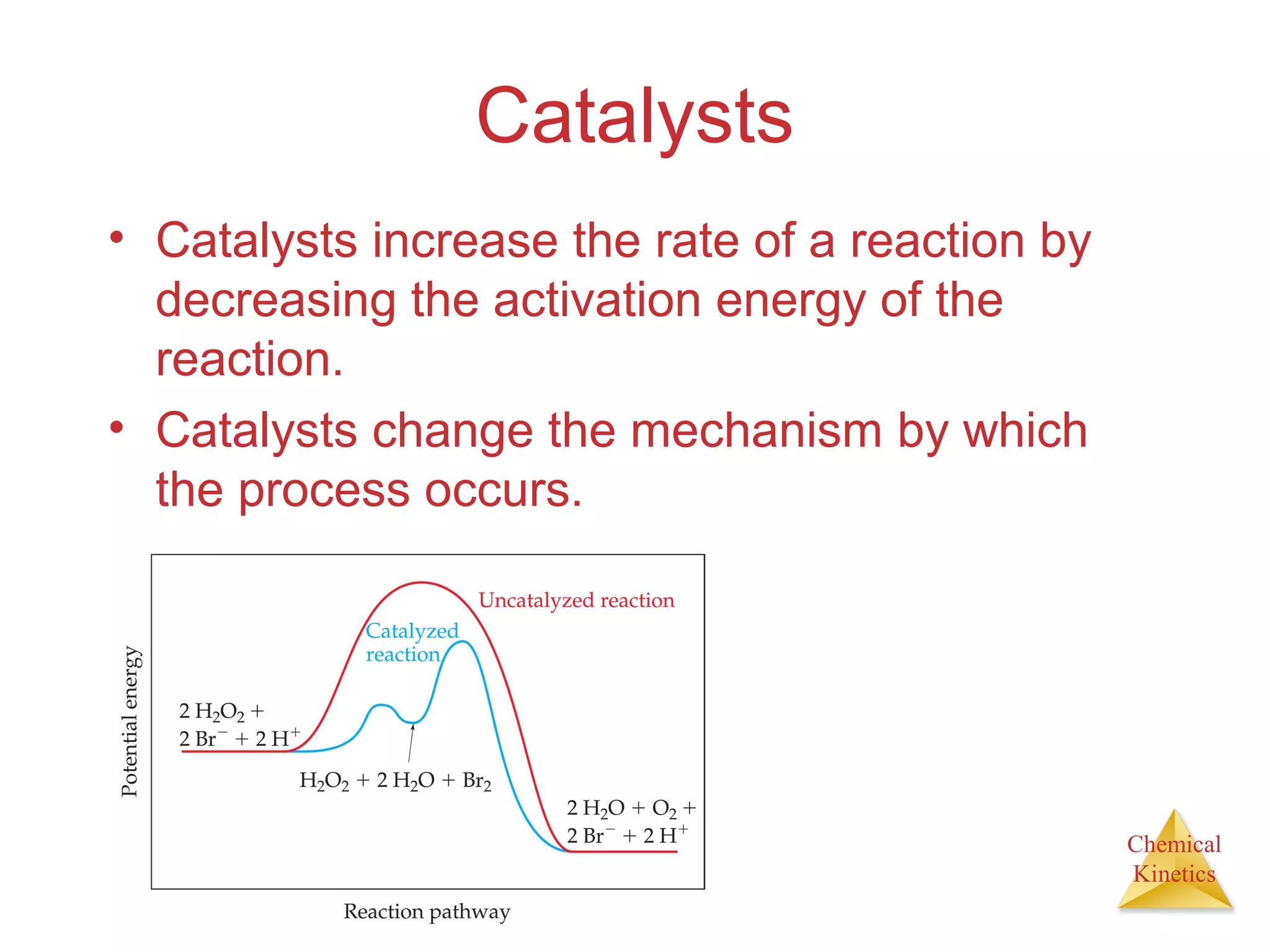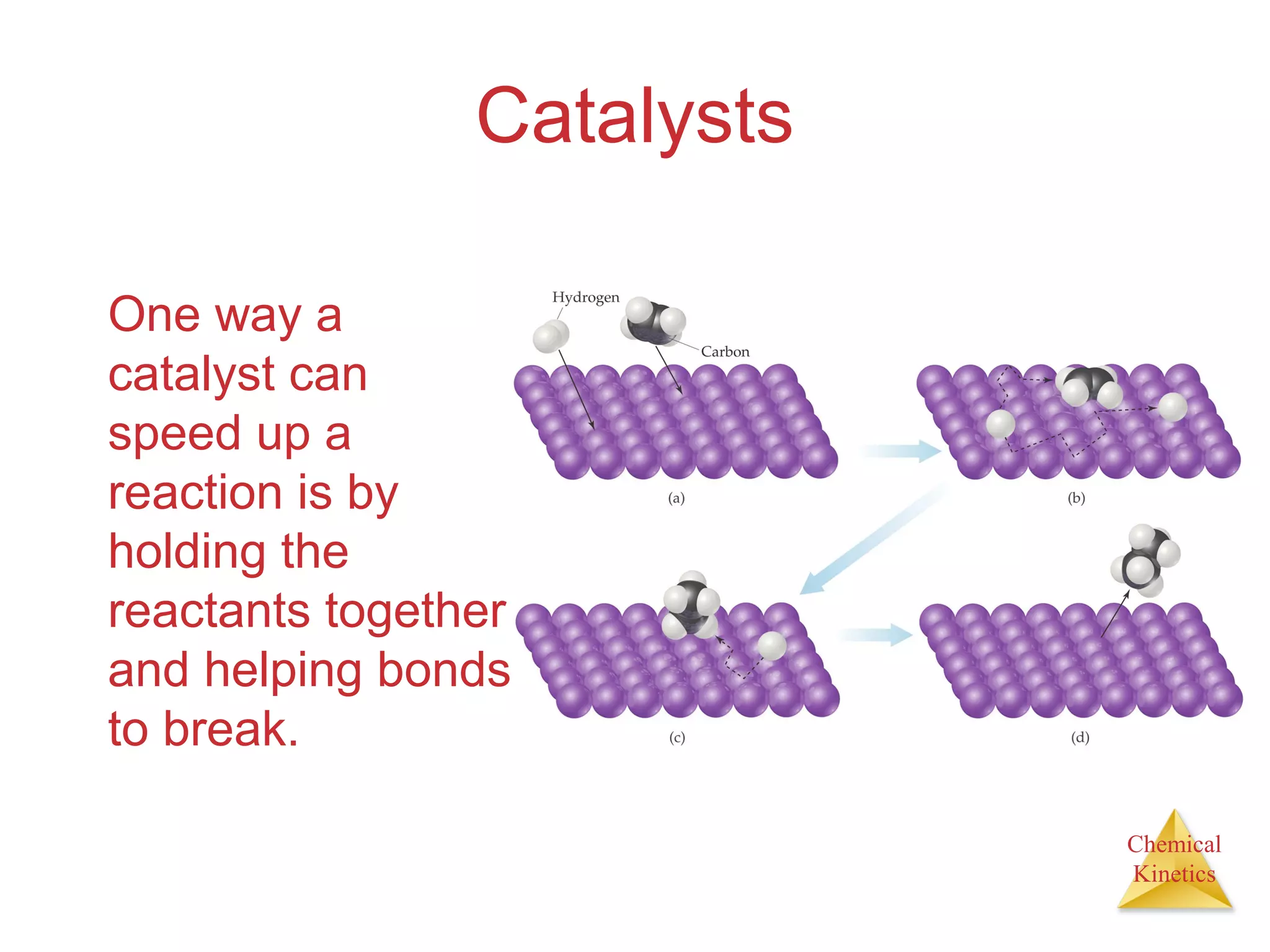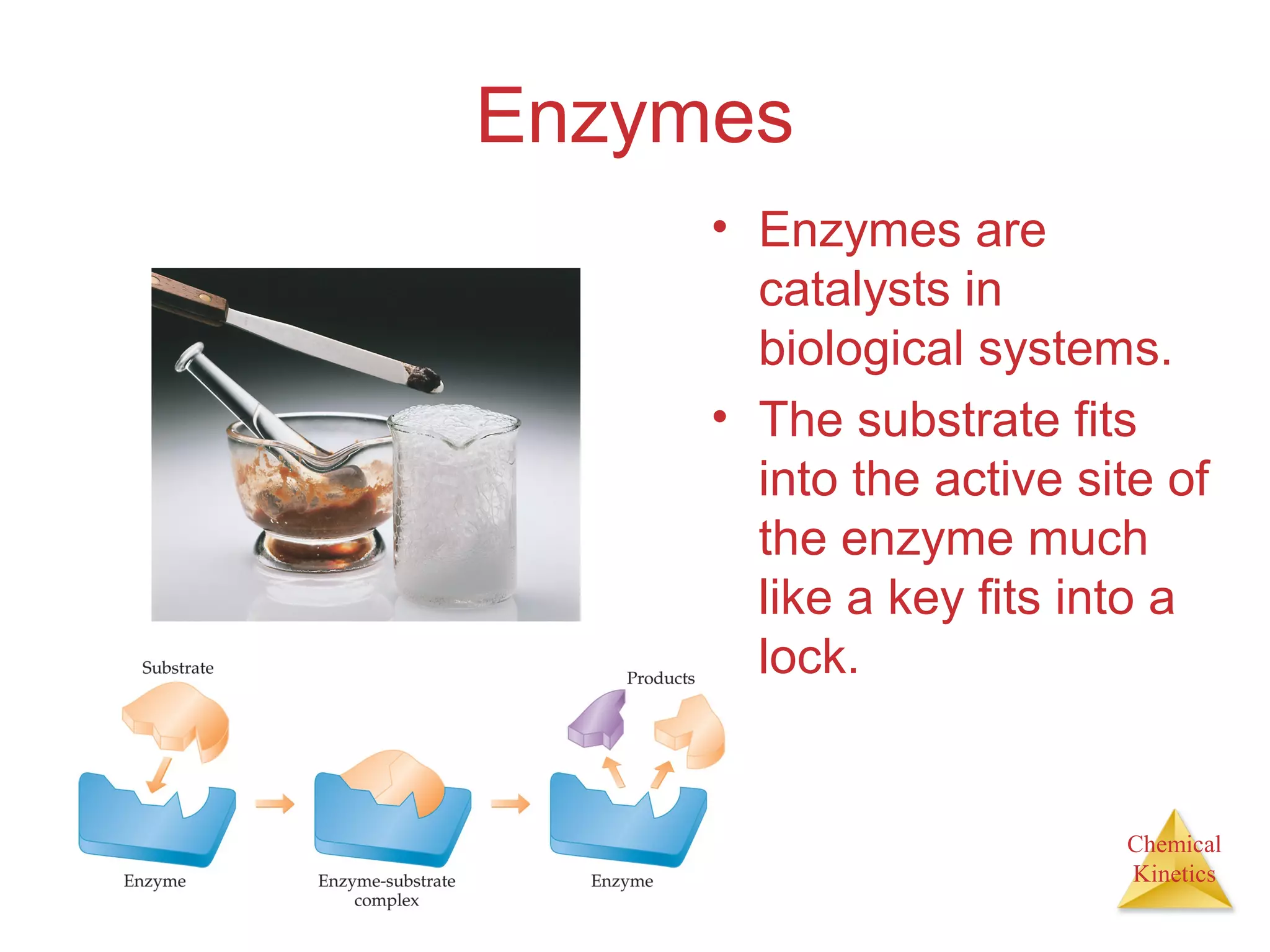This document discusses chemical kinetics and the factors that influence reaction rates. It explains that reaction rates are affected by the physical state and concentration of reactants, temperature, and presence of catalysts. The document also covers integrated rate laws for first-order and second-order reactions, reaction coordinate diagrams, Maxwell-Boltzmann distributions of molecular energies, and the Arrhenius equation relating reaction rate and activation energy.

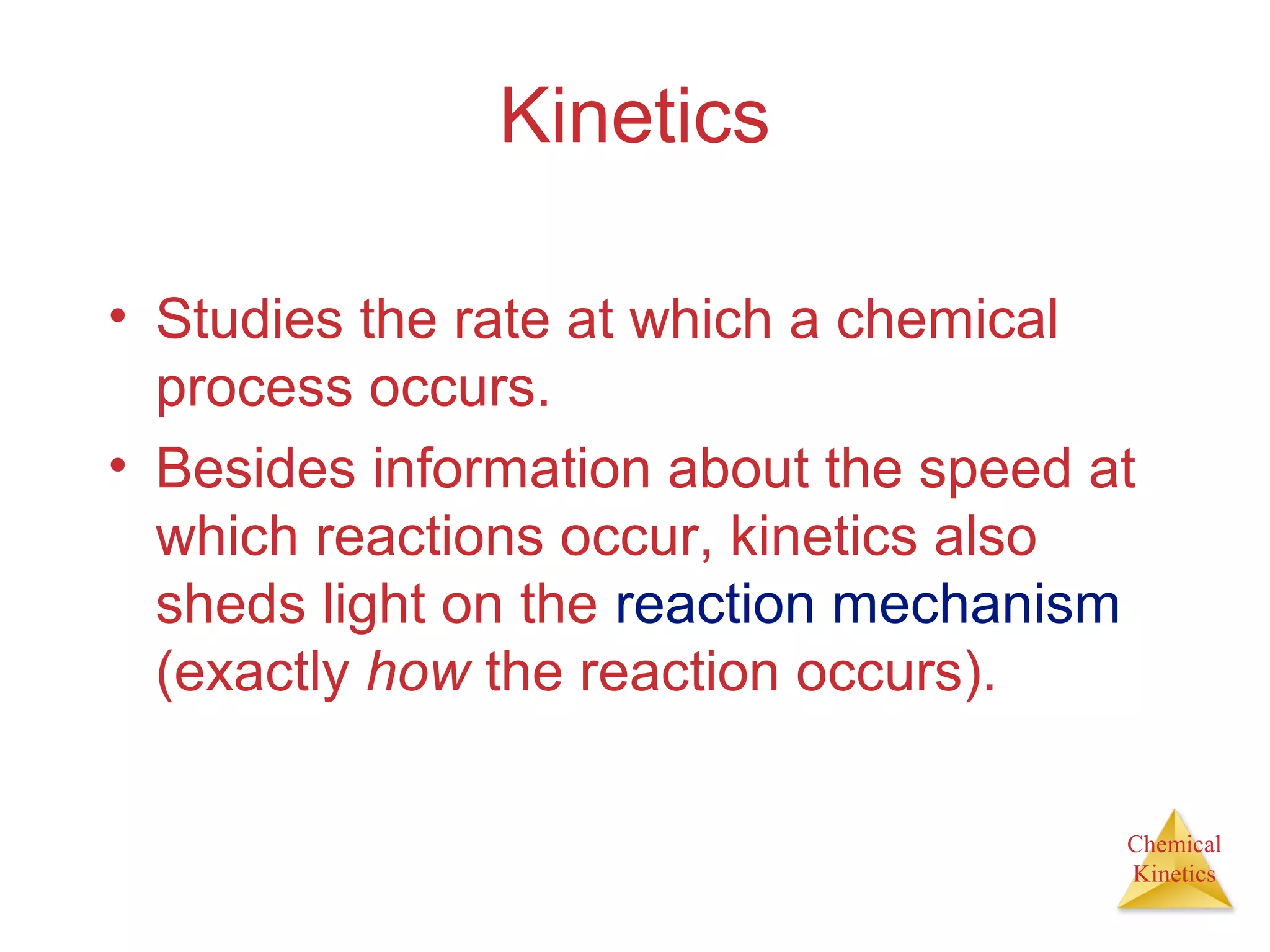
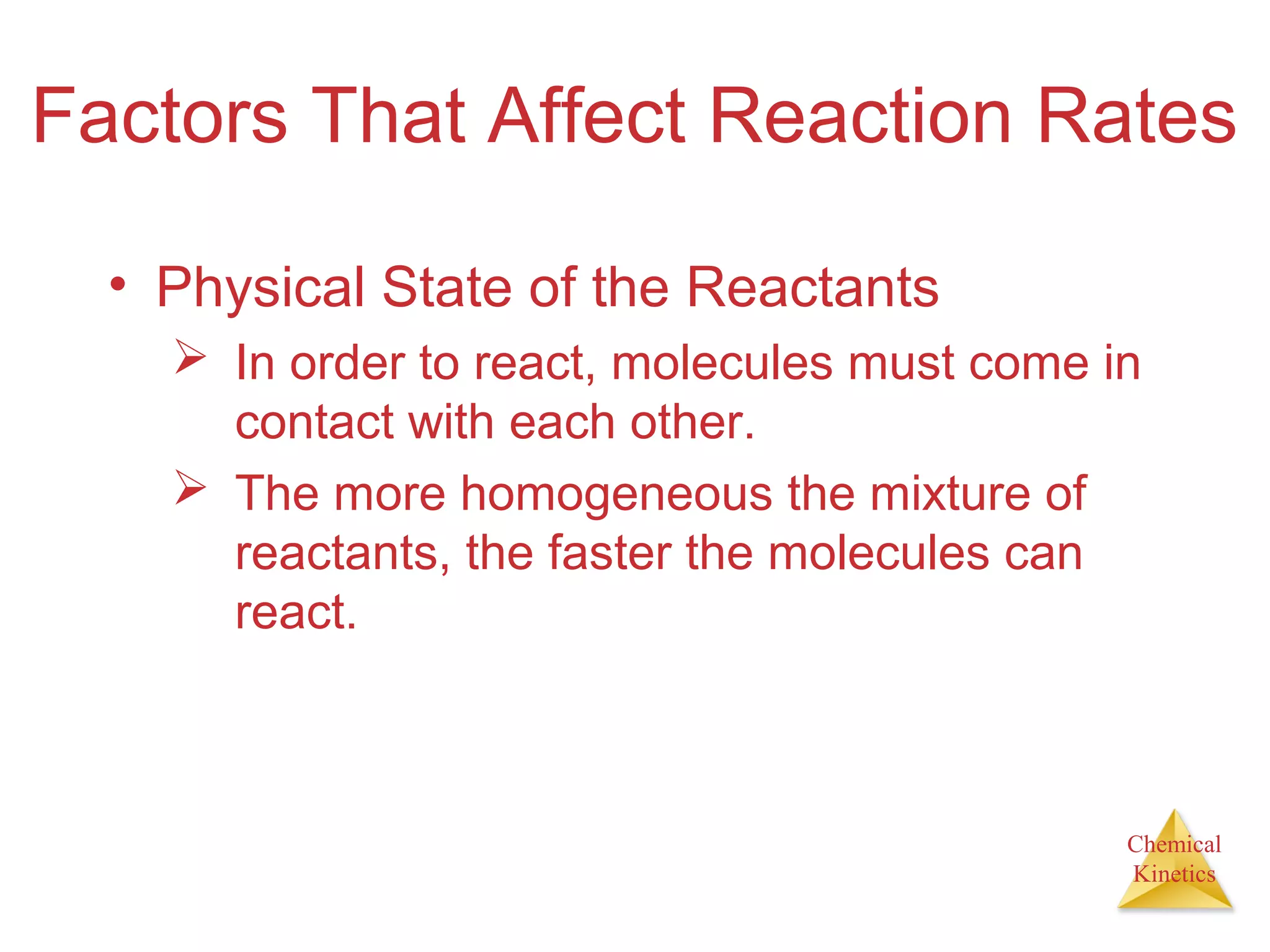
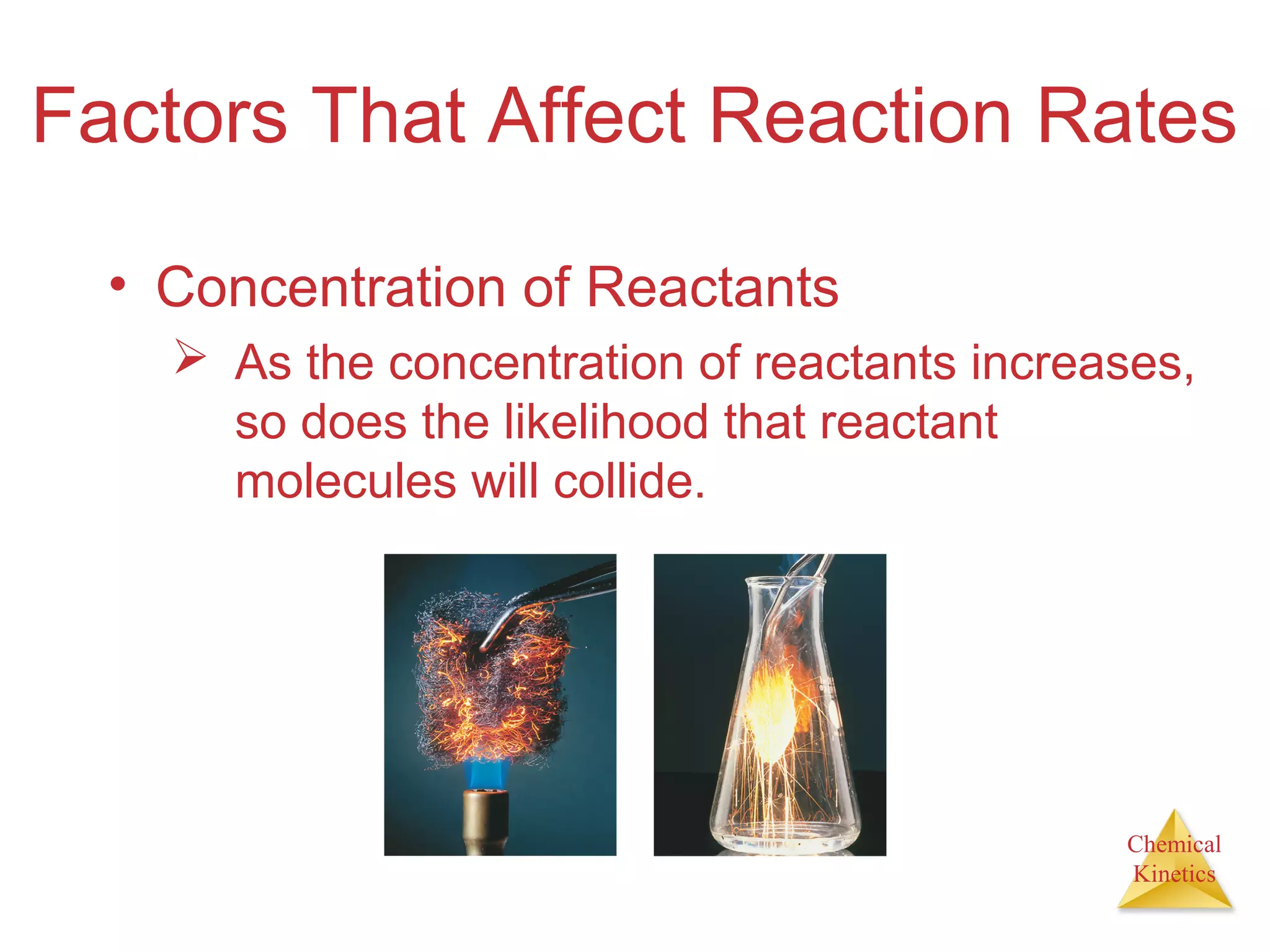
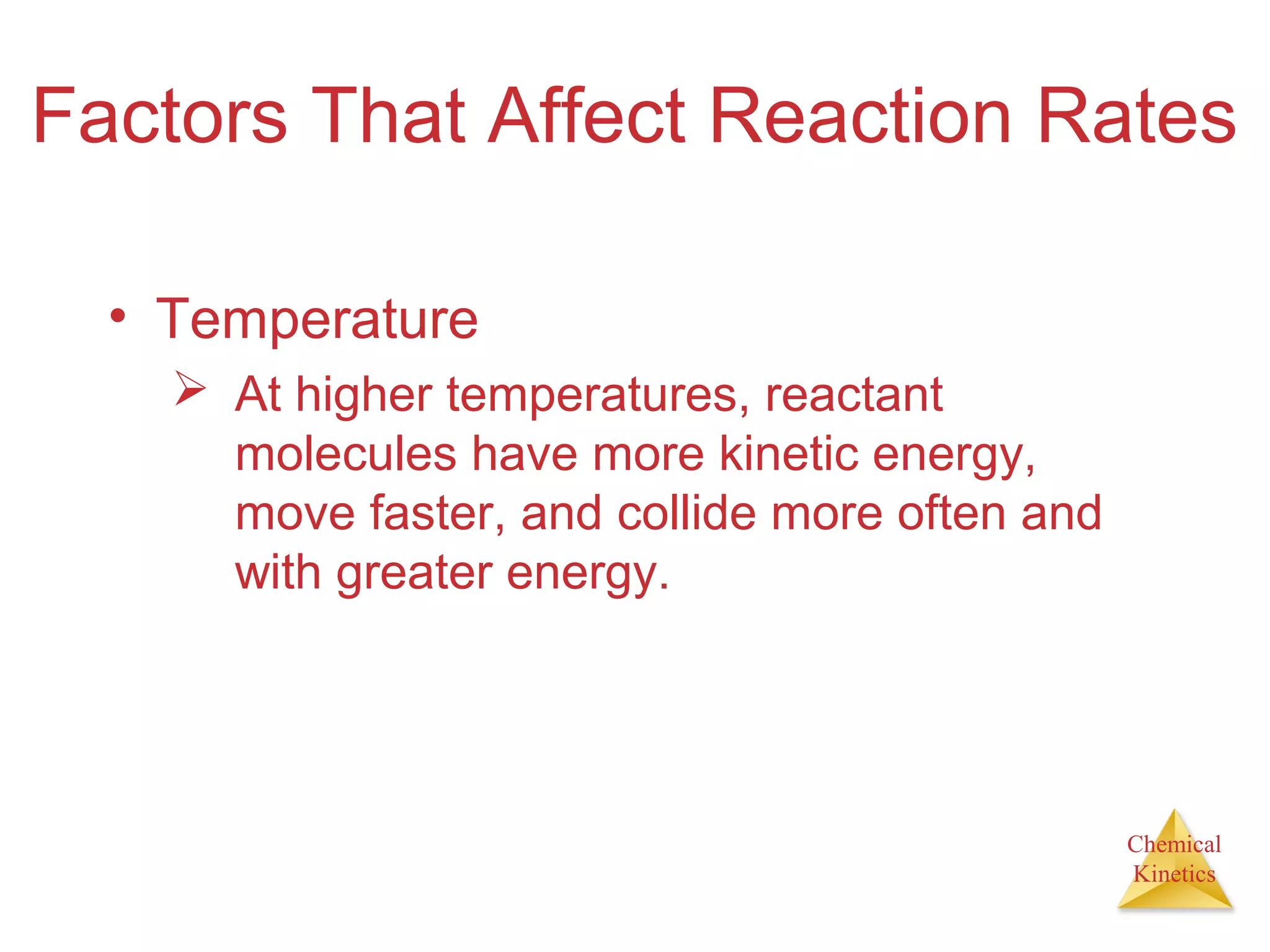
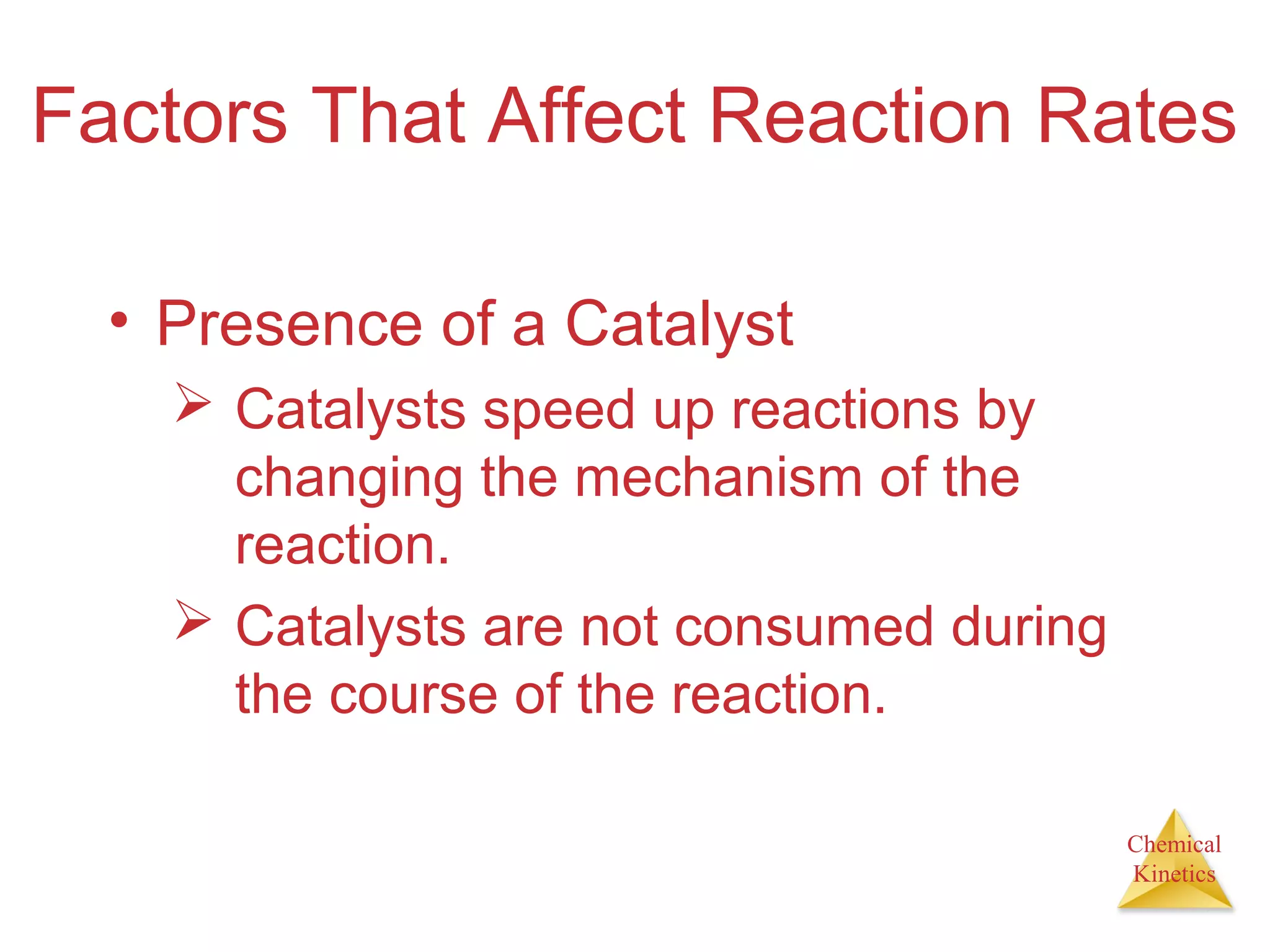
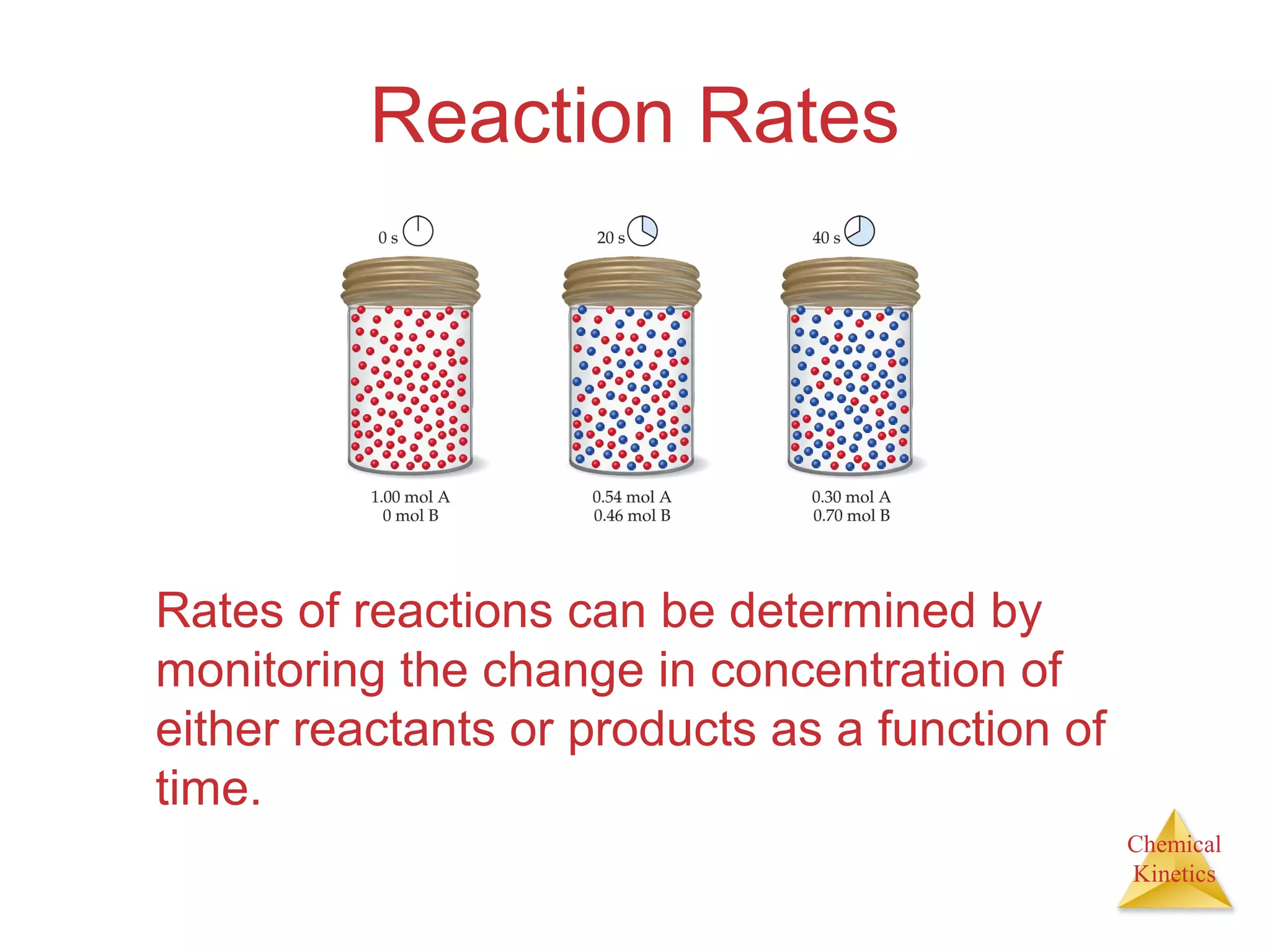
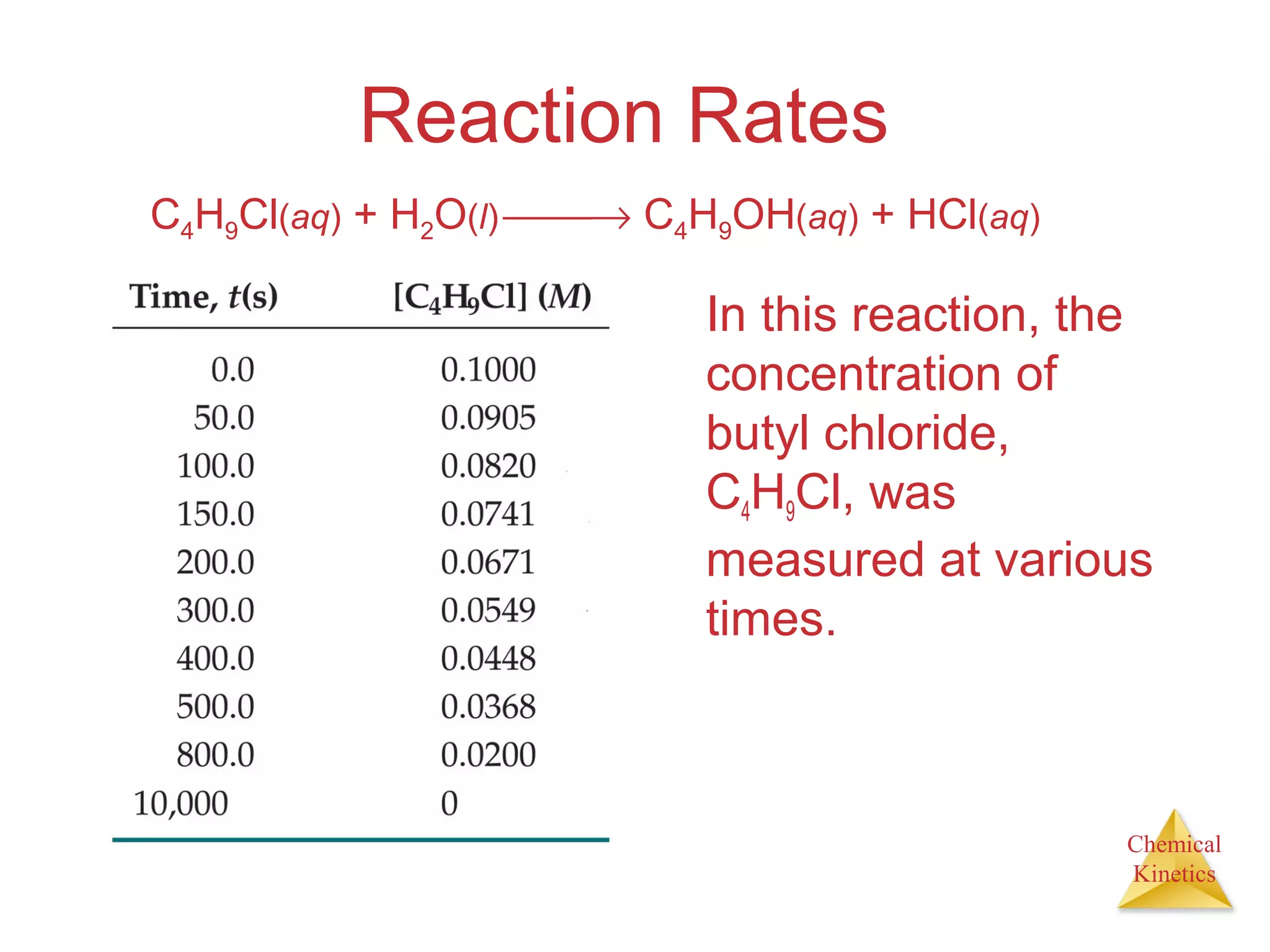
![Chemical
Kinetics
Reaction Rates
The average rate of
the reaction over
each interval is the
change in
concentration divided
by the change in time:
Average rate =
∆[C4H9Cl]
∆t
C4H9Cl(aq) + H2O(l) → C4H9OH(aq) + HCl(aq)](https://image.slidesharecdn.com/chapter14au-150116143226-conversion-gate02/75/Chapter-14-9-2048.jpg)
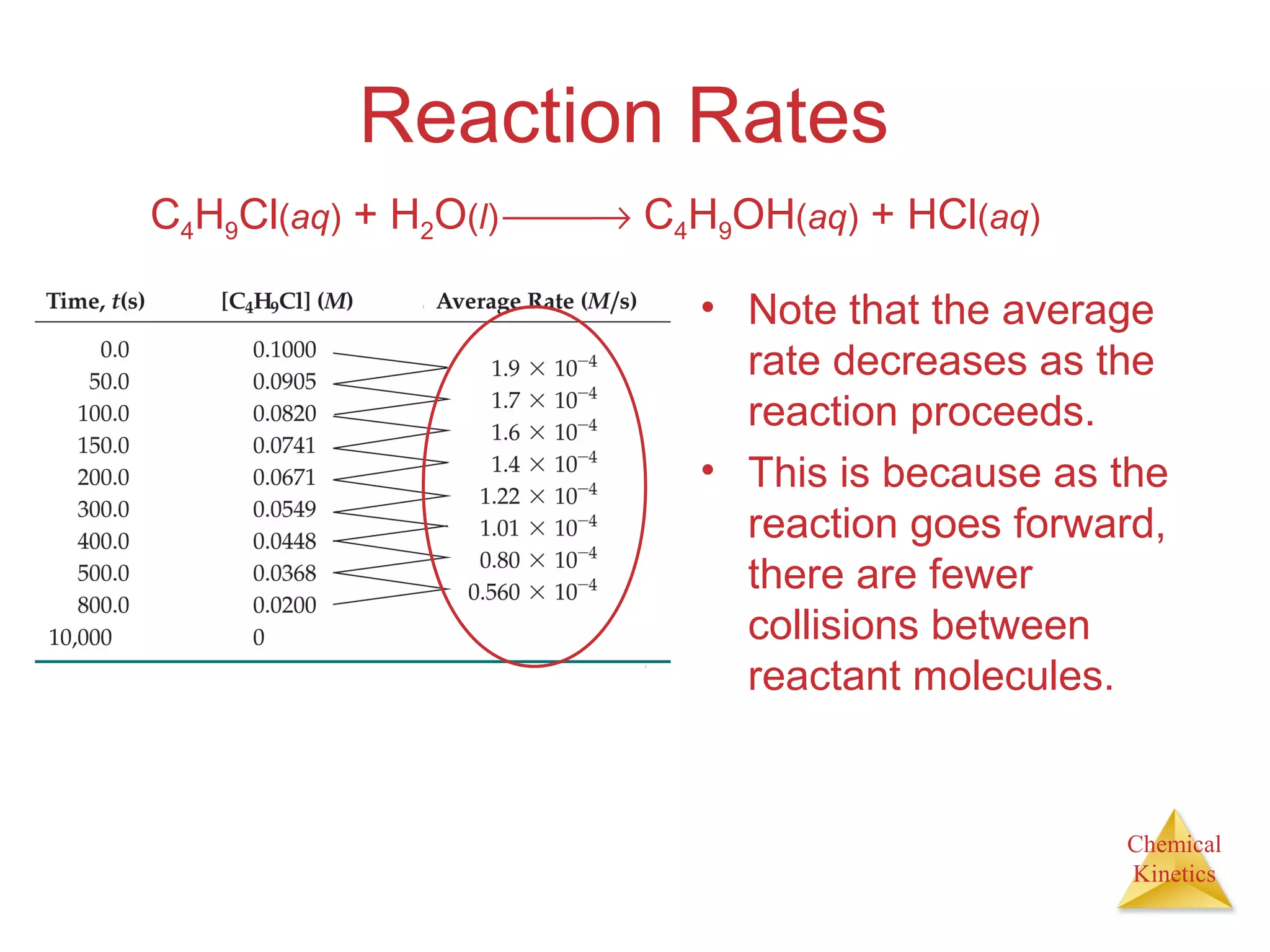
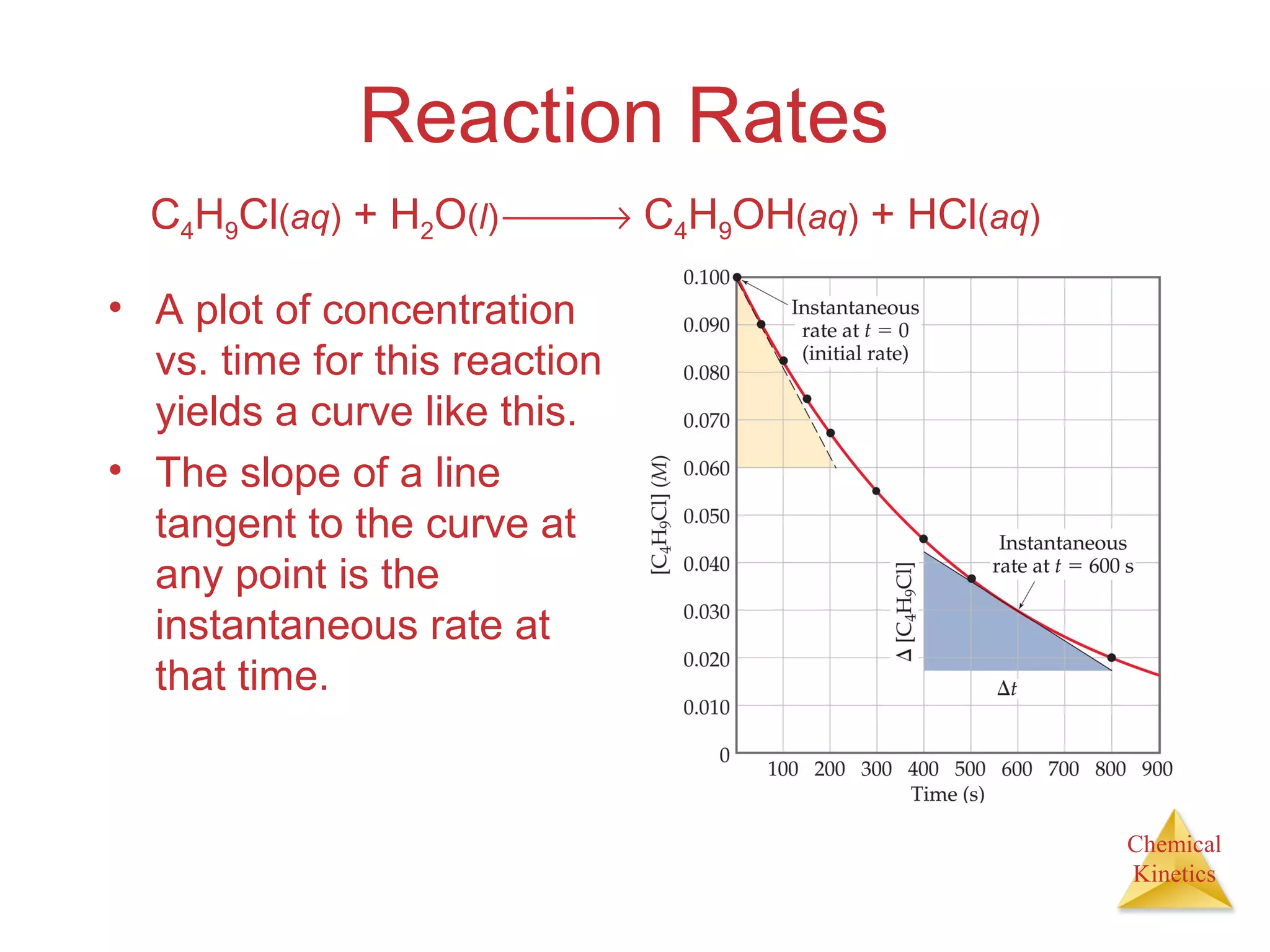

![Chemical
Kinetics
Reaction Rates and Stoichiometry
• In this reaction, the ratio
of C4H9Cl to C4H9OH is
1:1.
• Thus, the rate of
disappearance of C4H9Cl
is the same as the rate
of appearance of
C4H9OH.
C4H9Cl(aq) + H2O(l) → C4H9OH(aq) + HCl(aq)
Rate =
-∆[C4H9Cl]
∆t
=
∆[C4H9OH]
∆t](https://image.slidesharecdn.com/chapter14au-150116143226-conversion-gate02/75/Chapter-14-13-2048.jpg)
![Chemical
Kinetics
Reaction Rates and Stoichiometry
• What if the ratio is not 1:1?
2 HI(g) → H2(g) + I2(g)
•Therefore,
Rate = − 1
2
∆[HI]
∆t
=
∆[I2]
∆t](https://image.slidesharecdn.com/chapter14au-150116143226-conversion-gate02/75/Chapter-14-14-2048.jpg)
![Chemical
Kinetics
Reaction Rates and Stoichiometry
• To generalize, then, for the reaction
aA + bB cC + dD
Rate = −
1
a
∆[A]
∆t
= −
1
b
∆[B]
∆t
=
1
c
∆[C]
∆t
1
d
∆[D]
∆t
=](https://image.slidesharecdn.com/chapter14au-150116143226-conversion-gate02/75/Chapter-14-15-2048.jpg)
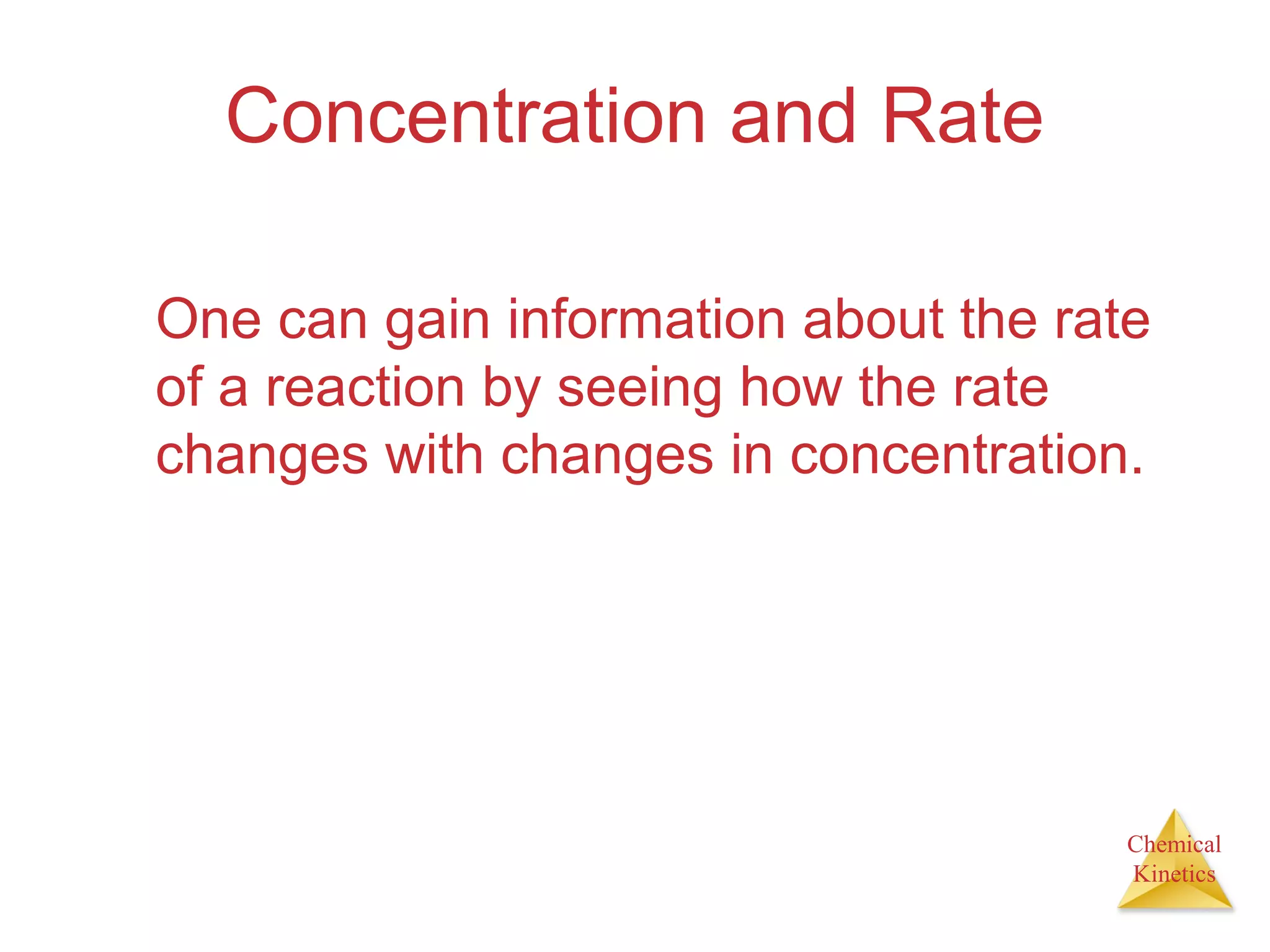
![Chemical
Kinetics
Concentration and Rate
Comparing Experiments 1 and 2, when [NH4
+
]
doubles, the initial rate doubles.
NH4
+
(aq) + NO2
−
(aq) N2(g) + 2 H2O(l)](https://image.slidesharecdn.com/chapter14au-150116143226-conversion-gate02/75/Chapter-14-17-2048.jpg)
![Chemical
Kinetics
Concentration and Rate
Likewise, comparing Experiments 5 and 6,
when [NO2
−
] doubles, the initial rate doubles.
NH4
+
(aq) + NO2
−
(aq) N2(g) + 2 H2O(l)](https://image.slidesharecdn.com/chapter14au-150116143226-conversion-gate02/75/Chapter-14-18-2048.jpg)
![Chemical
Kinetics
Concentration and Rate
• This means
Rate ∝ [NH4
+
]
Rate ∝ [NO2
−
]
Rate ∝ [NH+
] [NO2
−
]
or
Rate = k [NH4
+
] [NO2
−
]
• This equation is called the rate law, and
k is the rate constant.](https://image.slidesharecdn.com/chapter14au-150116143226-conversion-gate02/75/Chapter-14-19-2048.jpg)
![Chemical
Kinetics
Rate Laws
• A rate law shows the relationship
between the reaction rate and the
concentrations of reactants.
• The exponents tell the order of the
reaction with respect to each reactant.
• This reaction is
First-order in [NH4
+
]
First-order in [NO2
−
]](https://image.slidesharecdn.com/chapter14au-150116143226-conversion-gate02/75/Chapter-14-20-2048.jpg)
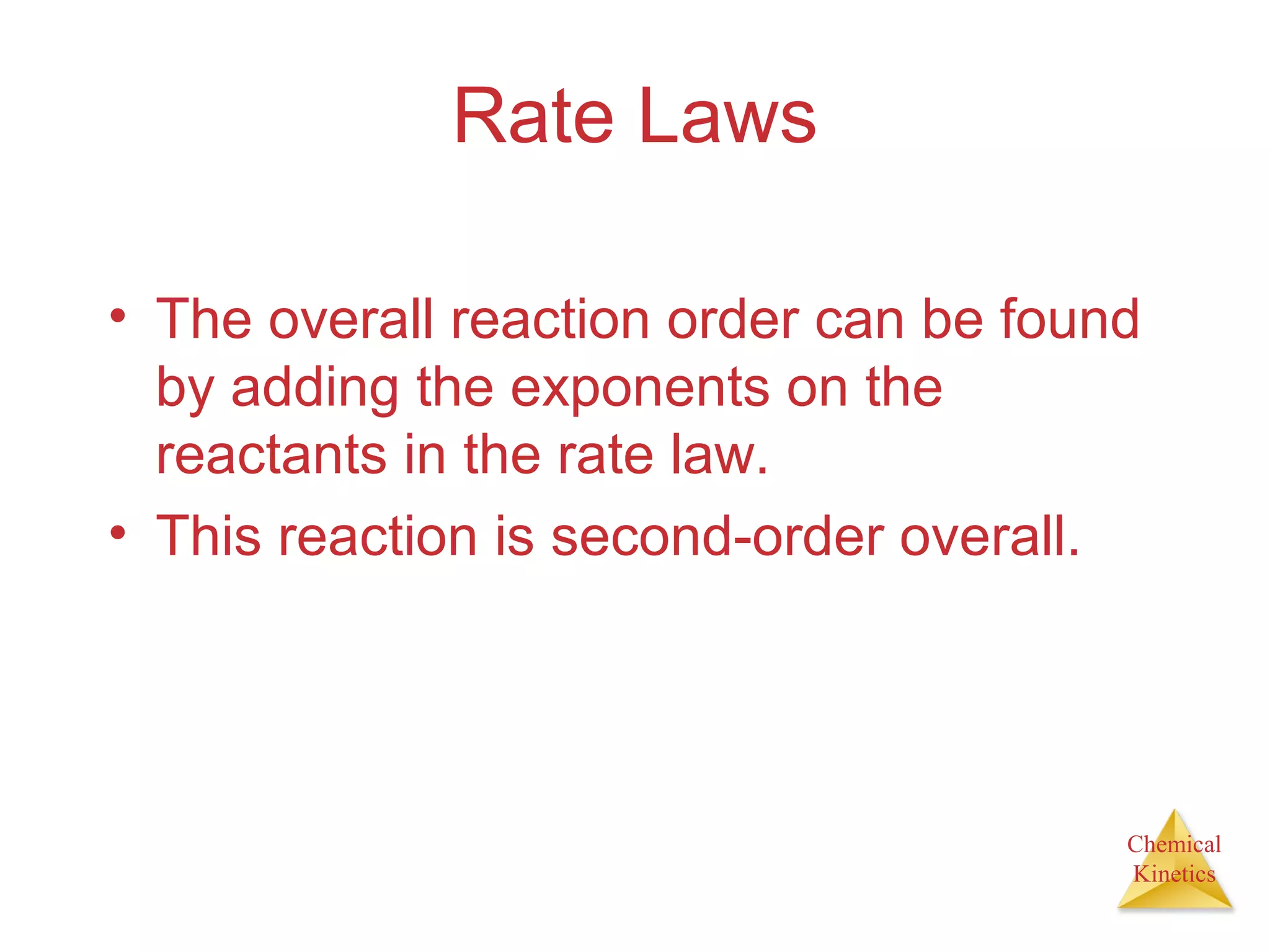
![Chemical
Kinetics
Integrated Rate Laws
Using calculus to integrate the rate law
for a first-order process gives us
ln
[A]t
[A]0
= −kt
Where
[A]0 is the initial concentration of A.
[A]t is the concentration of A at some time, t,
during the course of the reaction.](https://image.slidesharecdn.com/chapter14au-150116143226-conversion-gate02/75/Chapter-14-22-2048.jpg)
![Chemical
Kinetics
Integrated Rate Laws
Manipulating this equation produces…
ln
[A]t
[A]0
= −kt
ln [A]t − ln [A]0 = − kt
ln [A]t = − kt + ln [A]0
…which is in the form
y = mx + b](https://image.slidesharecdn.com/chapter14au-150116143226-conversion-gate02/75/Chapter-14-23-2048.jpg)
![Chemical
Kinetics
First-Order Processes
Therefore, if a reaction is first-order, a
plot of ln [A] vs. t will yield a straight
line, and the slope of the line will be -k.
ln [A]t = -kt + ln [A]0](https://image.slidesharecdn.com/chapter14au-150116143226-conversion-gate02/75/Chapter-14-24-2048.jpg)
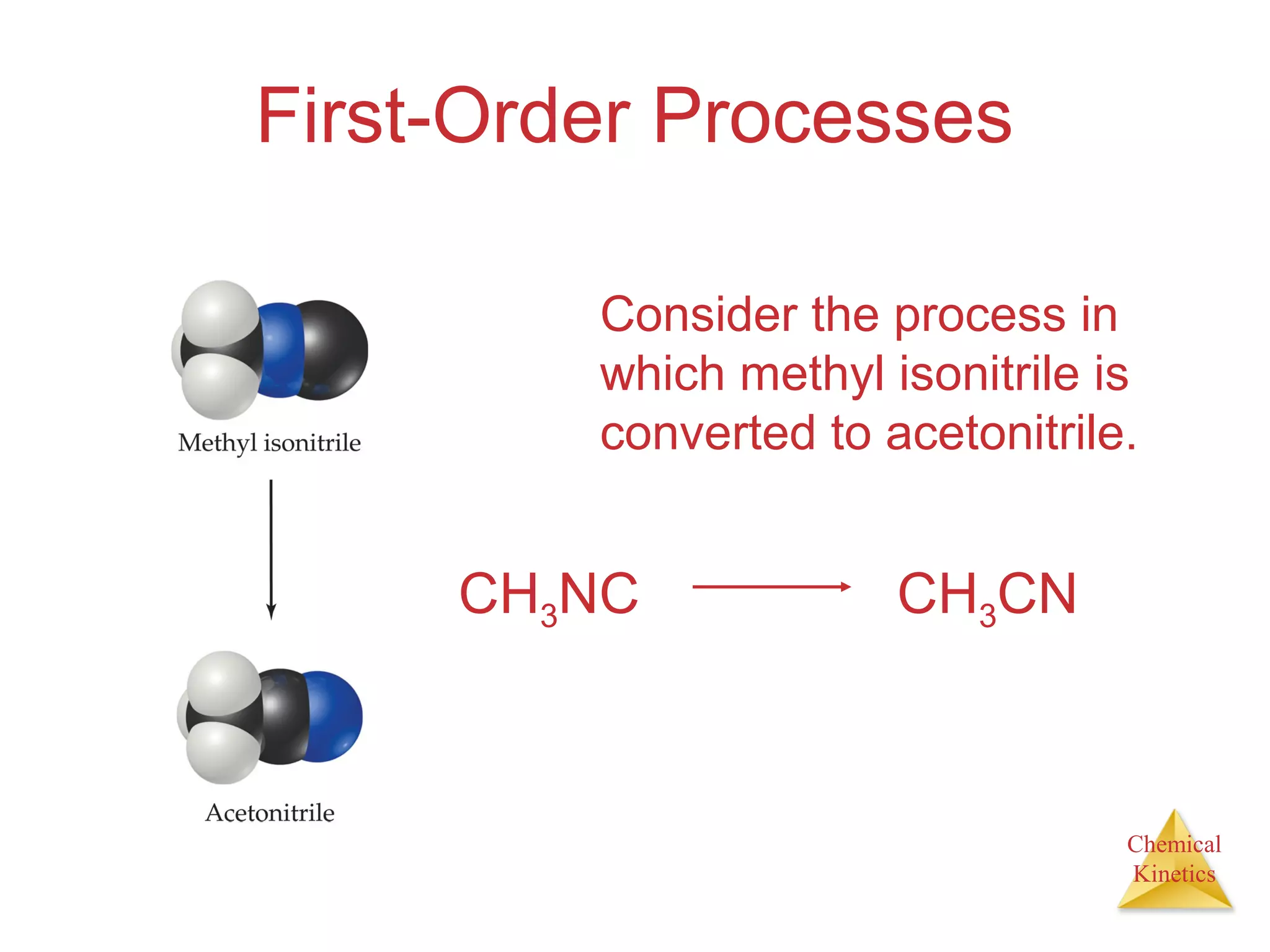
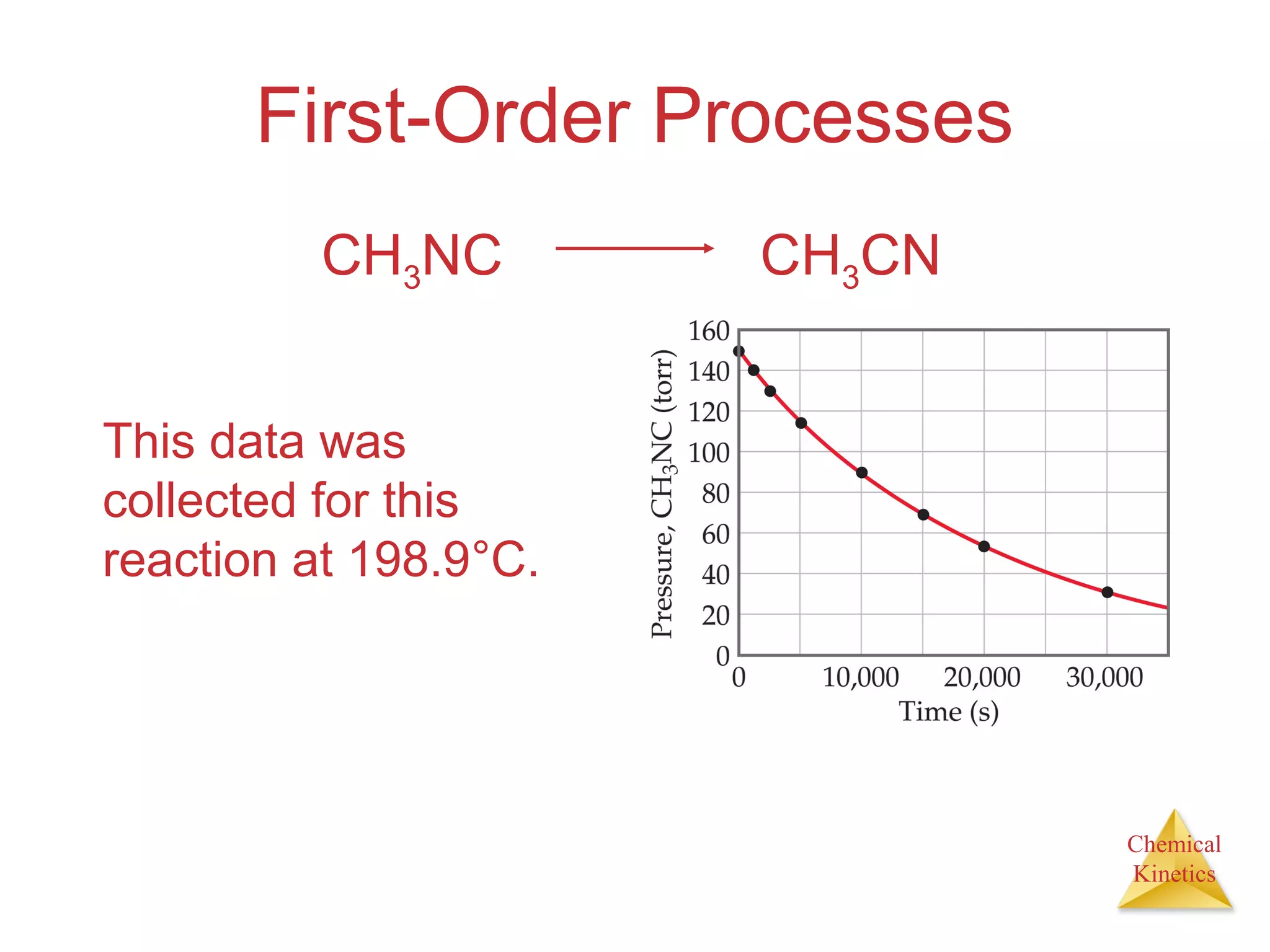
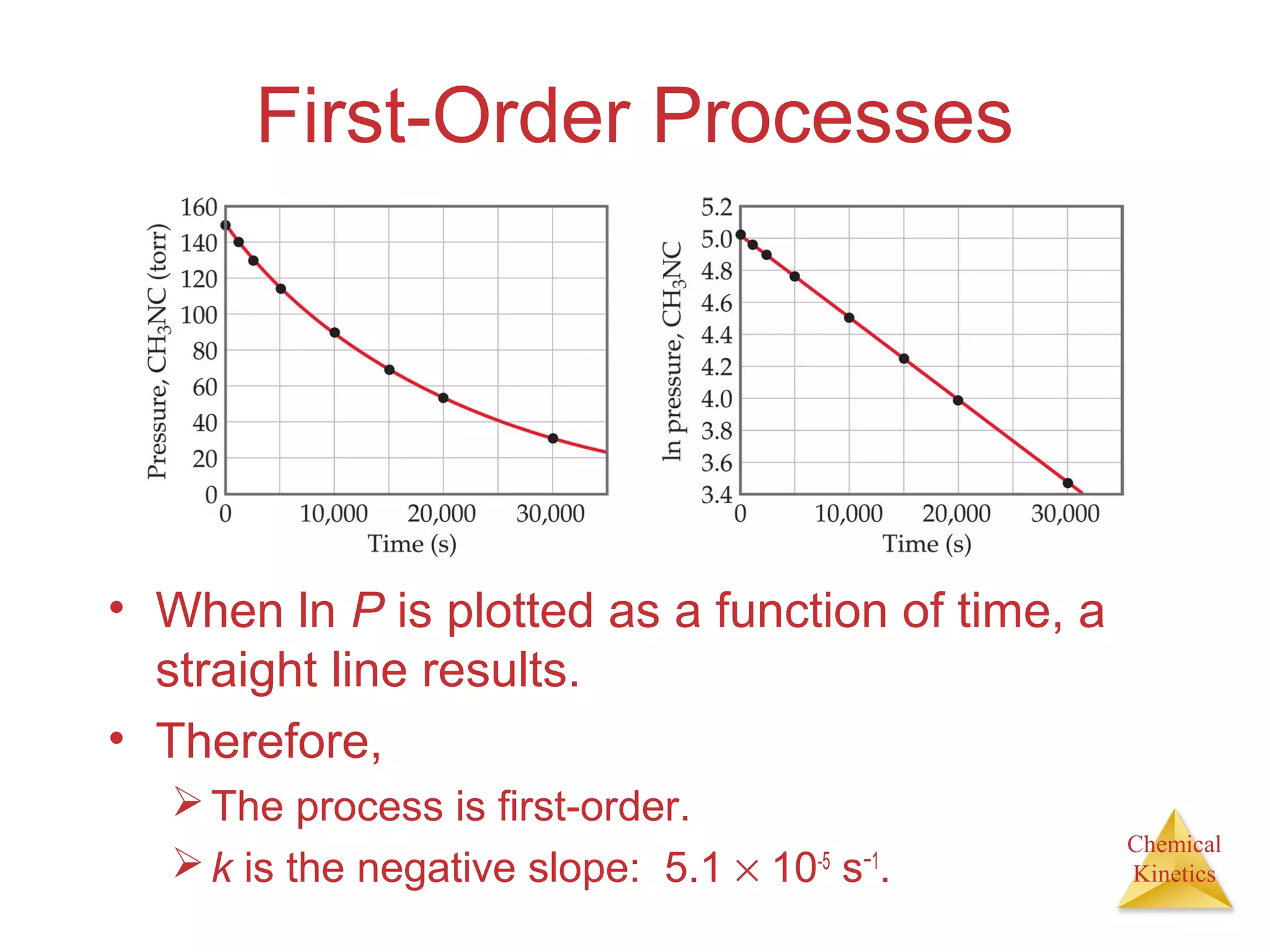
![Chemical
Kinetics
Second-Order Processes
Similarly, integrating the rate law for a
process that is second-order in reactant
A, we get
1
[A]t
= −kt +
1
[A]0
also in the form
y = mx + b](https://image.slidesharecdn.com/chapter14au-150116143226-conversion-gate02/75/Chapter-14-28-2048.jpg)
![Chemical
Kinetics
Second-Order Processes
So if a process is second-order in A, a
plot of 1/[A] vs. t will yield a straight line,
and the slope of that line is k.
1
[A]t
= −kt +
1
[A]0](https://image.slidesharecdn.com/chapter14au-150116143226-conversion-gate02/75/Chapter-14-29-2048.jpg)
![Chemical
Kinetics
Second-Order Processes
The decomposition of NO2 at 300°C is described by
the equation
NO2 (g) NO (g) + 1/2 O2 (g)
and yields data comparable to this:
Time (s) [NO2], M
0.0 0.01000
50.0 0.00787
100.0 0.00649
200.0 0.00481
300.0 0.00380](https://image.slidesharecdn.com/chapter14au-150116143226-conversion-gate02/75/Chapter-14-30-2048.jpg)
![Chemical
Kinetics
Second-Order Processes
• Graphing ln [NO2] vs. t
yields:
Time (s) [NO2], M ln [NO2]
0.0 0.01000 −4.610
50.0 0.00787 −4.845
100.0 0.00649 −5.038
200.0 0.00481 −5.337
300.0 0.00380 −5.573
• The plot is not a straight
line, so the process is not
first-order in [A].](https://image.slidesharecdn.com/chapter14au-150116143226-conversion-gate02/75/Chapter-14-31-2048.jpg)
![Chemical
Kinetics
Second-Order Processes
• Graphing ln 1/
[NO2] vs. t,
however, gives this
plot.
Time (s) [NO2], M 1/[NO2]
0.0 0.01000 100
50.0 0.00787 127
100.0 0.00649 154
200.0 0.00481 208
300.0 0.00380 263
• Because this is a
straight line, the
process is second-
order in [A].](https://image.slidesharecdn.com/chapter14au-150116143226-conversion-gate02/75/Chapter-14-32-2048.jpg)
![Chemical
Kinetics
Half-Life
• Half-life is defined
as the time required
for one-half of a
reactant to react.
• Because [A] at t1/2 is
one-half of the
original [A],
[A]t = 0.5 [A]0.](https://image.slidesharecdn.com/chapter14au-150116143226-conversion-gate02/75/Chapter-14-33-2048.jpg)
![Chemical
Kinetics
Half-Life
For a first-order process, this becomes
0.5 [A]0
[A]0
ln = −kt1/2
ln 0.5 = −kt1/2
−0.693 = −kt1/2
= t1/2
0.693
kNOTE: For a first-order
process, the half-life does
not depend on [A]0.](https://image.slidesharecdn.com/chapter14au-150116143226-conversion-gate02/75/Chapter-14-34-2048.jpg)
![Chemical
Kinetics
Half-Life
For a second-order process,
1
0.5 [A]0
= kt1/2 +
1
[A]0
2
[A]0
= kt1/2 +
1
[A]0
2 − 1
[A]0
= kt1/2
1
[A]0
=
= t1/2
1
k[A]0](https://image.slidesharecdn.com/chapter14au-150116143226-conversion-gate02/75/Chapter-14-35-2048.jpg)
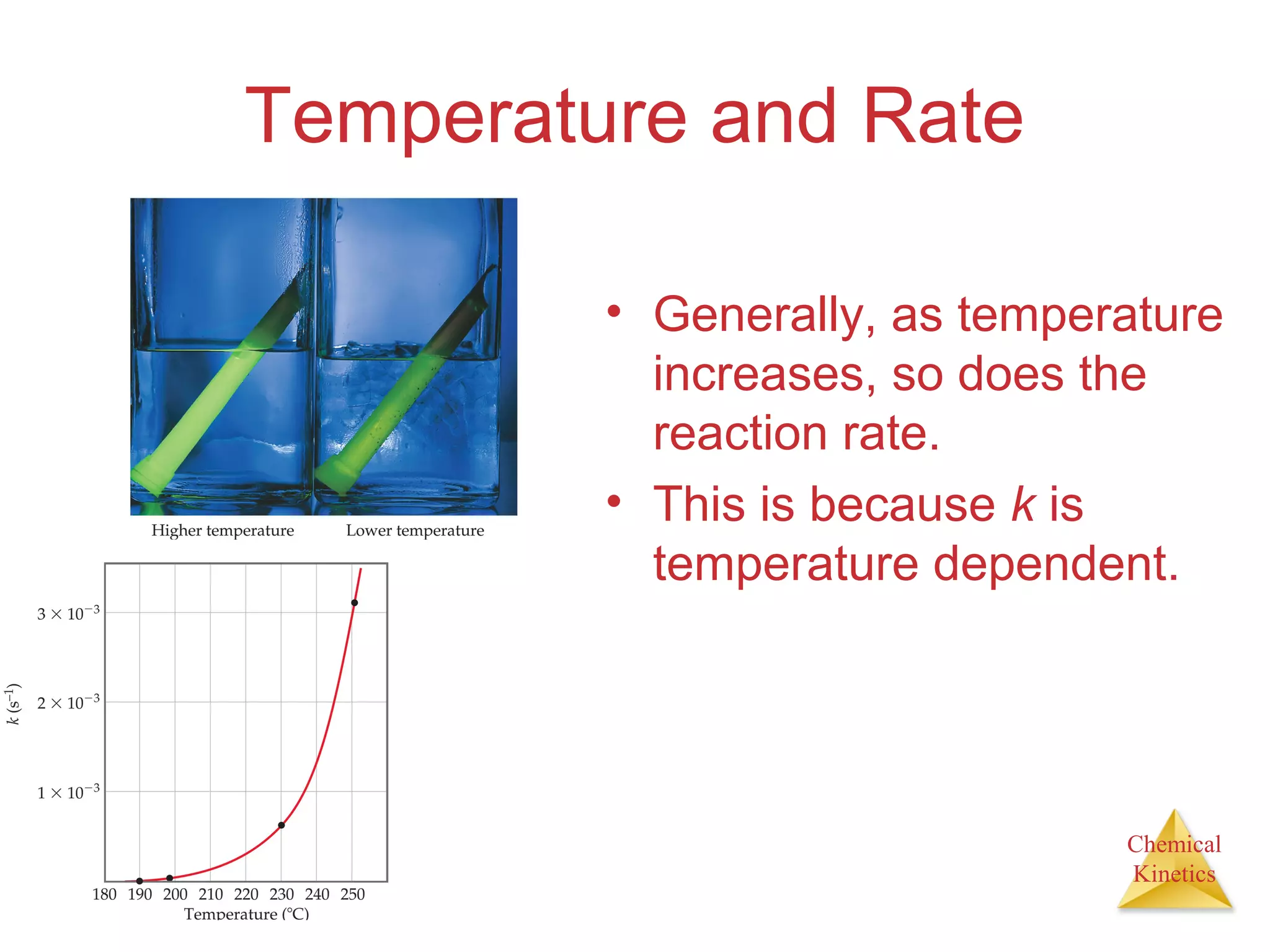
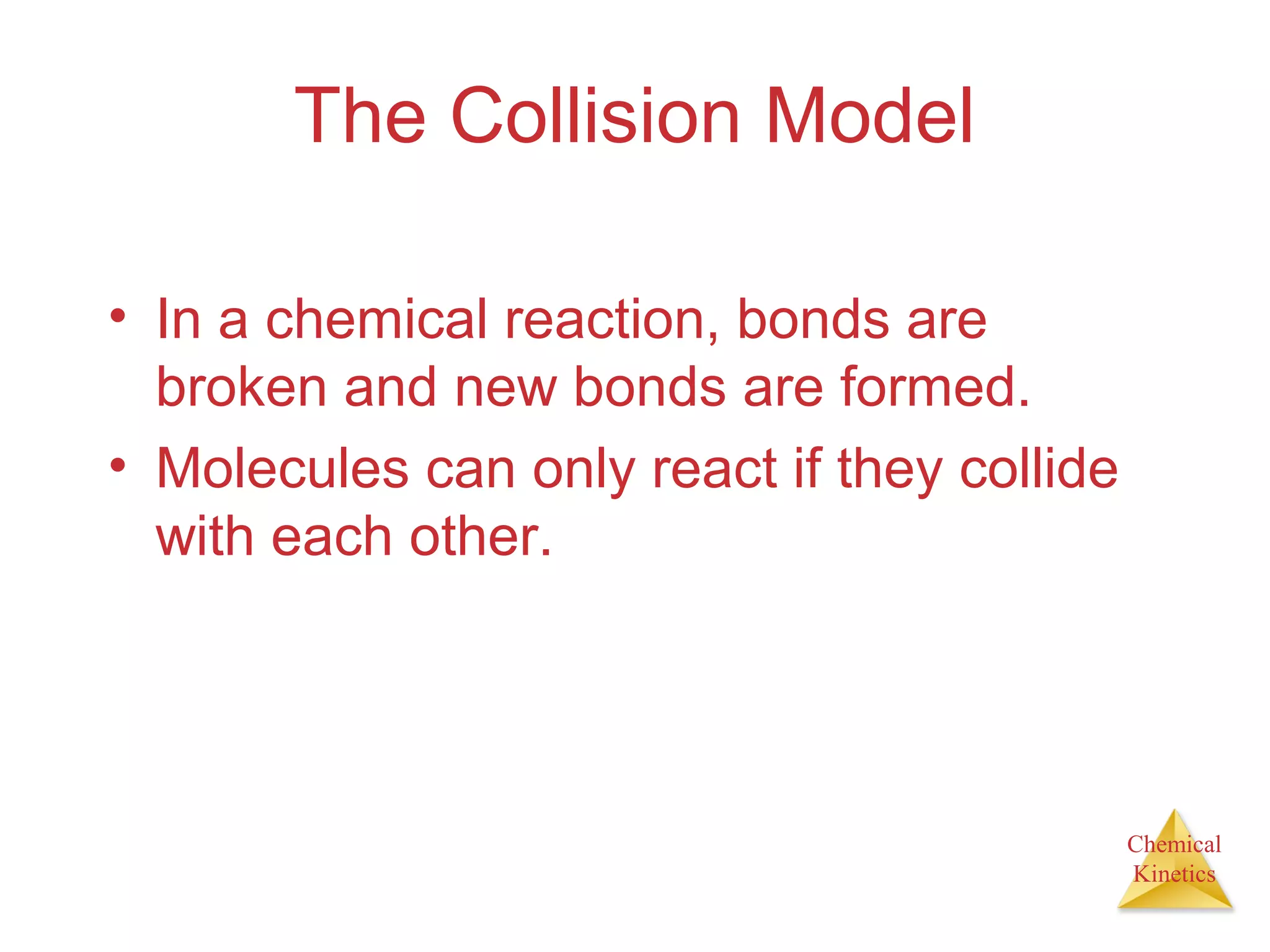
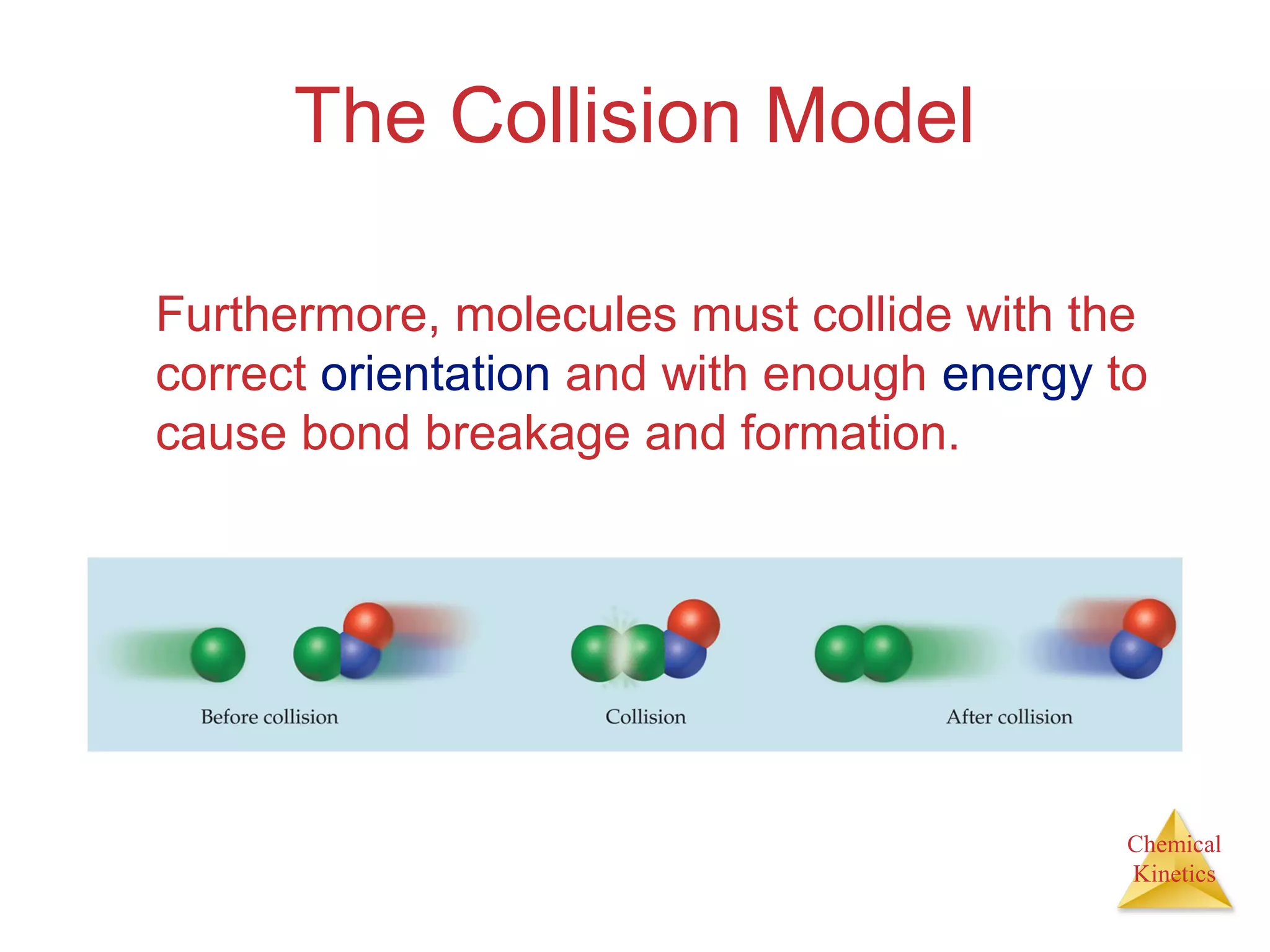
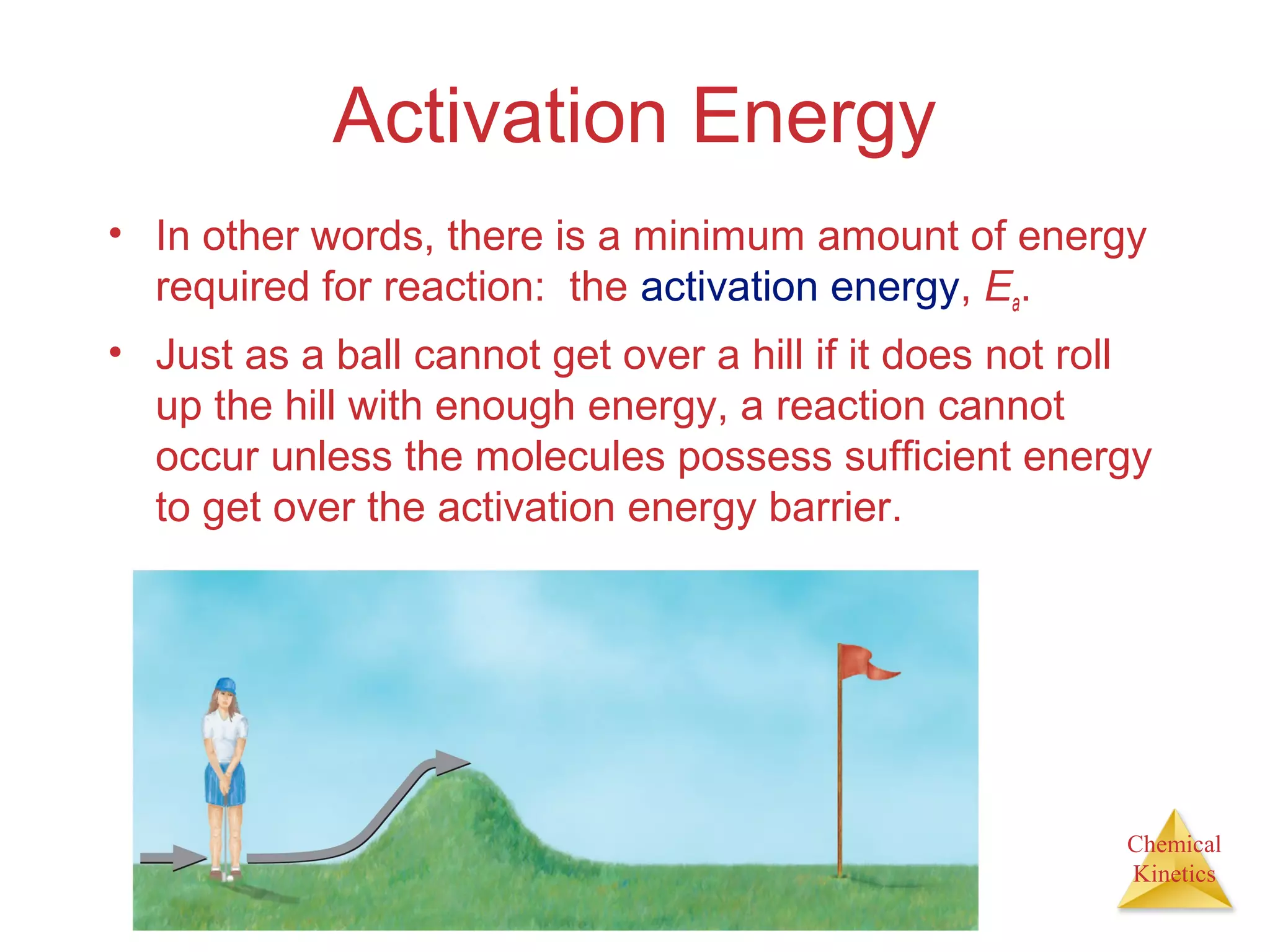
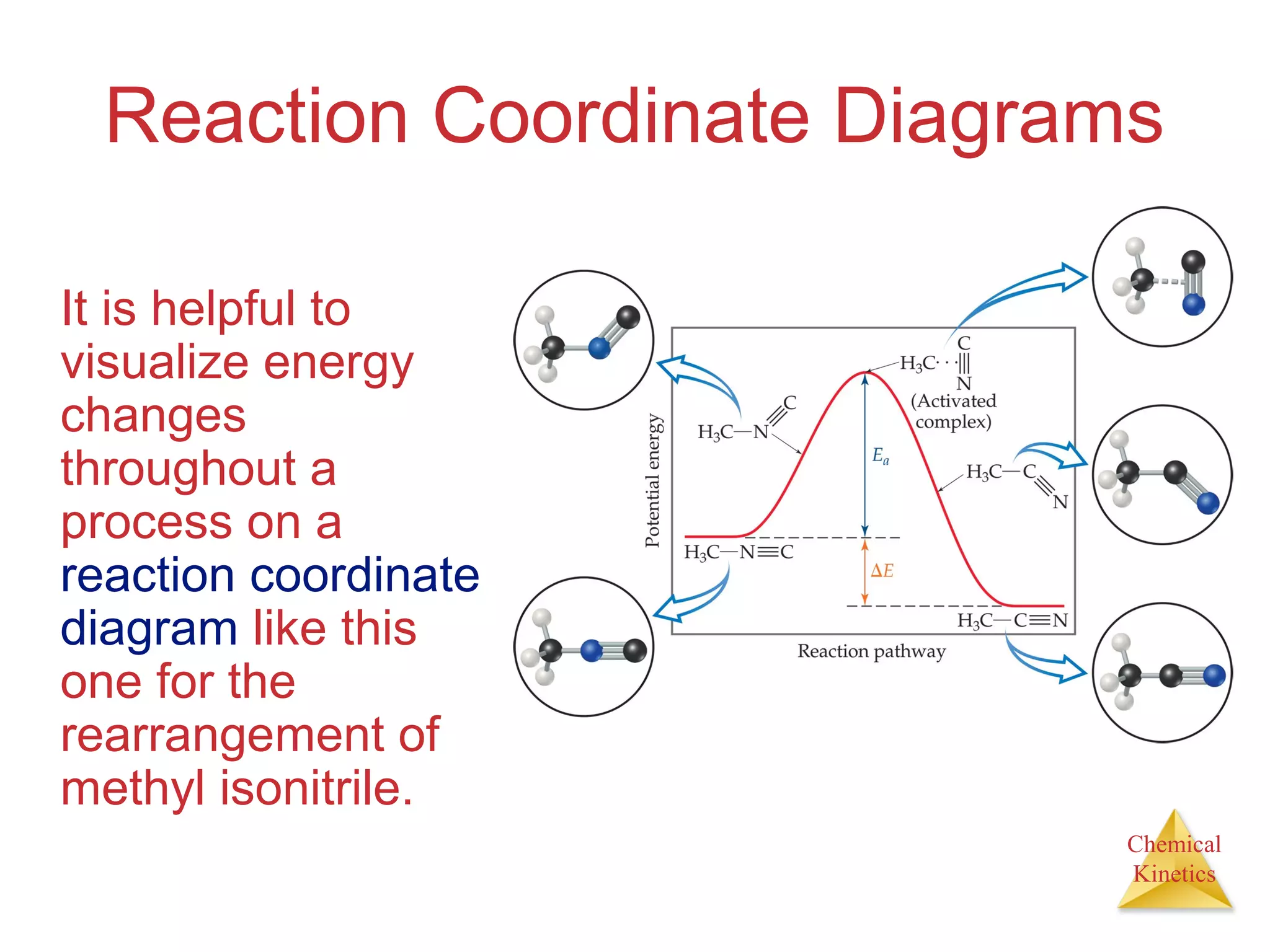
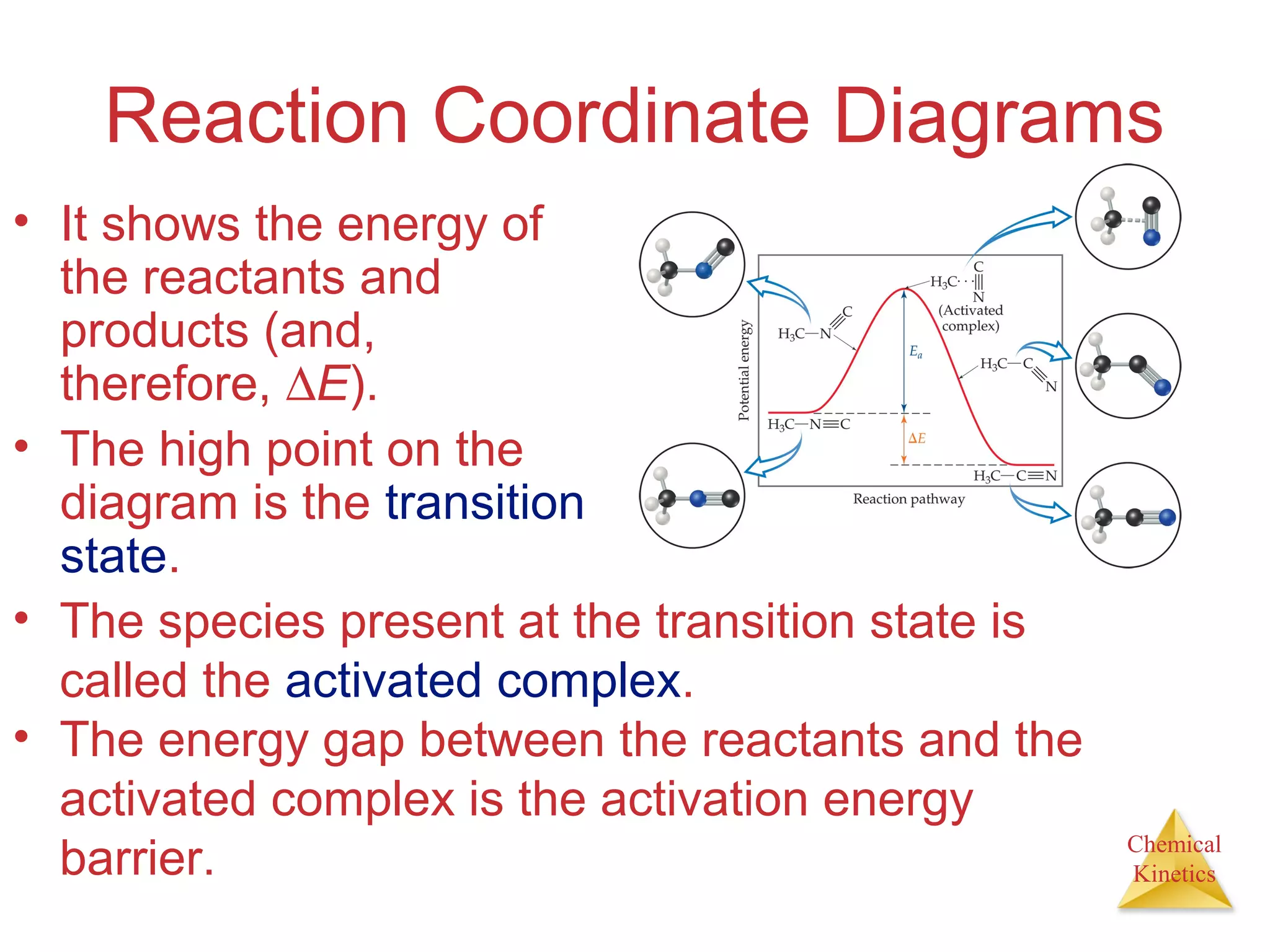

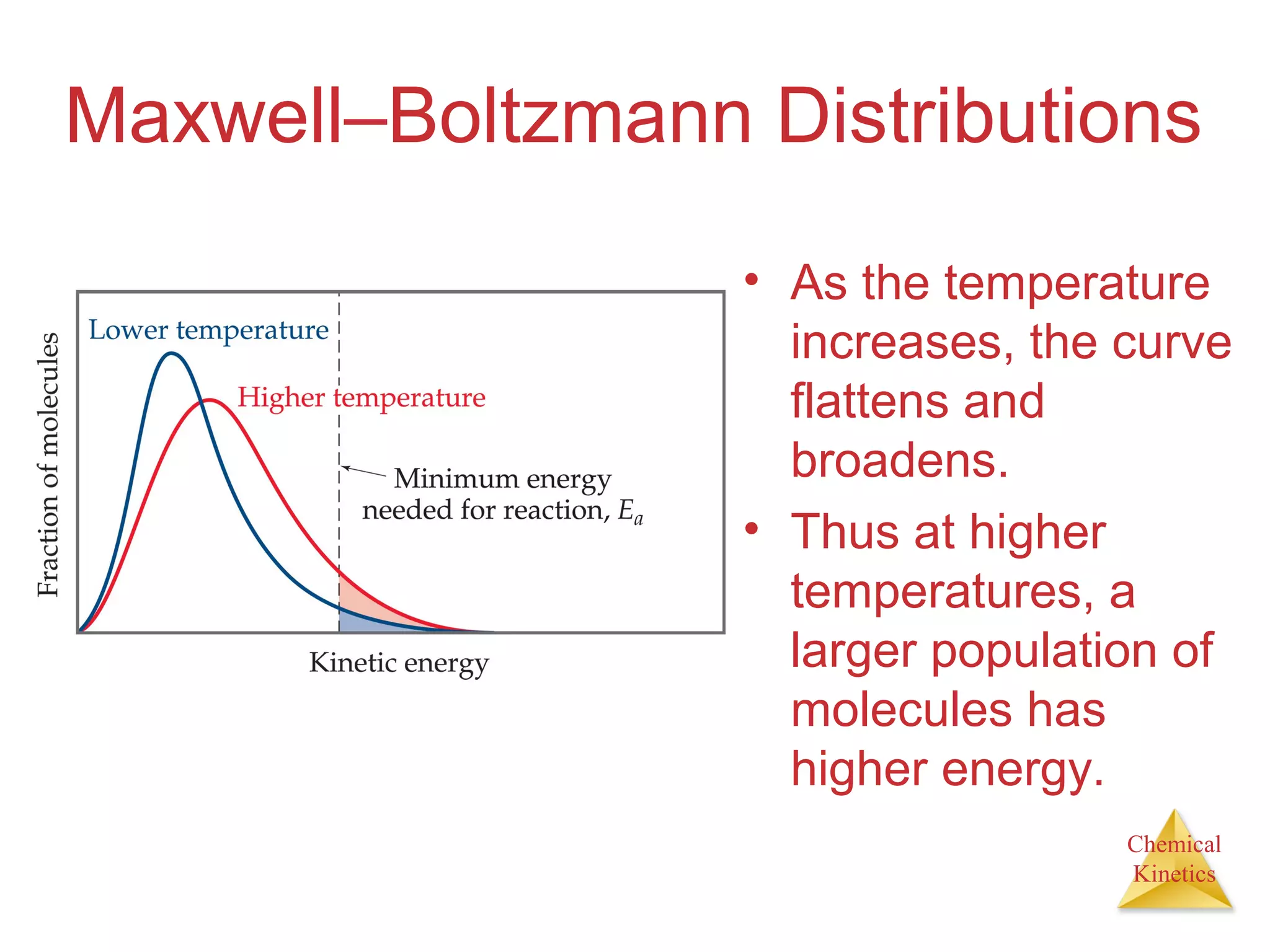

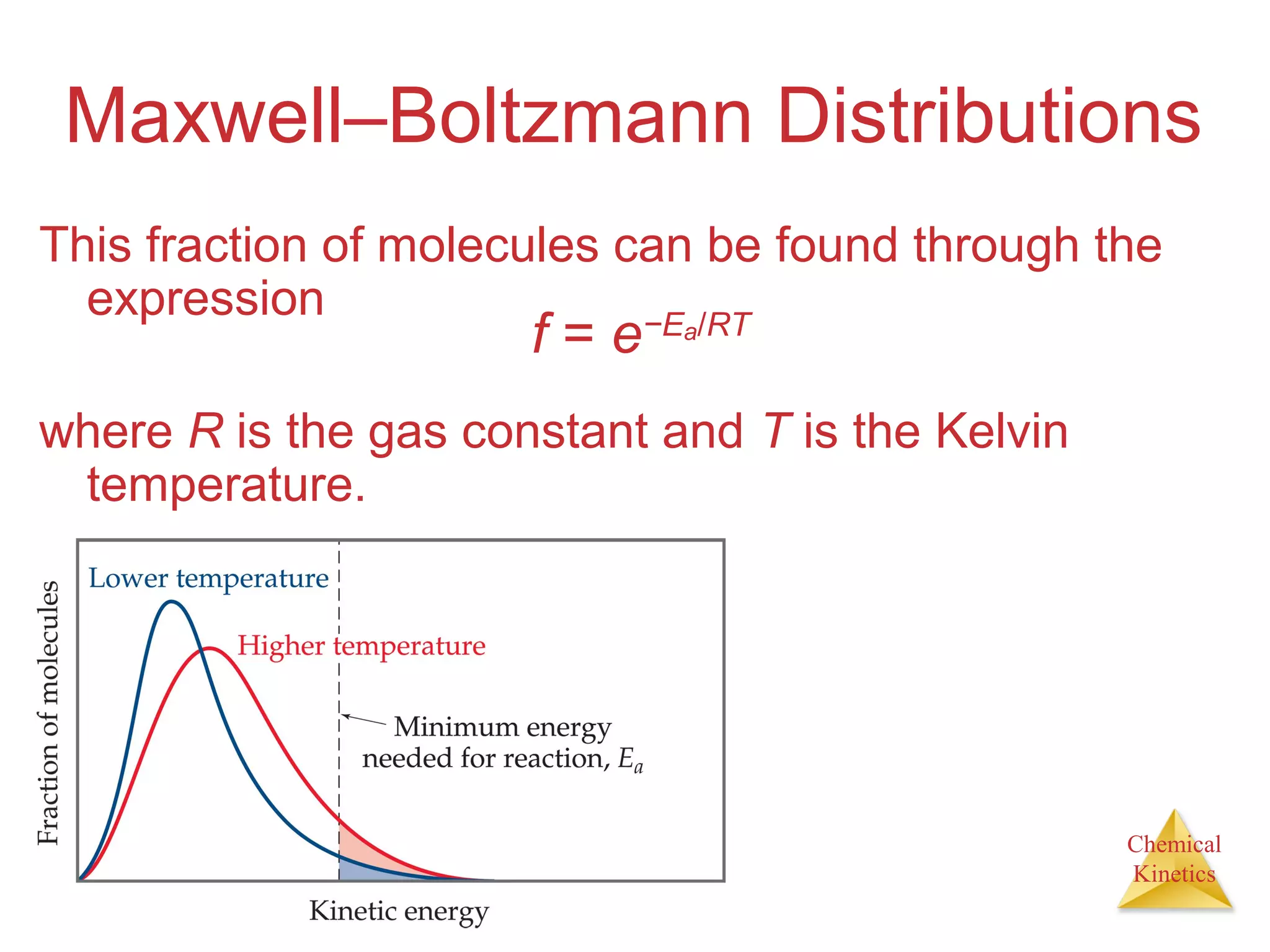
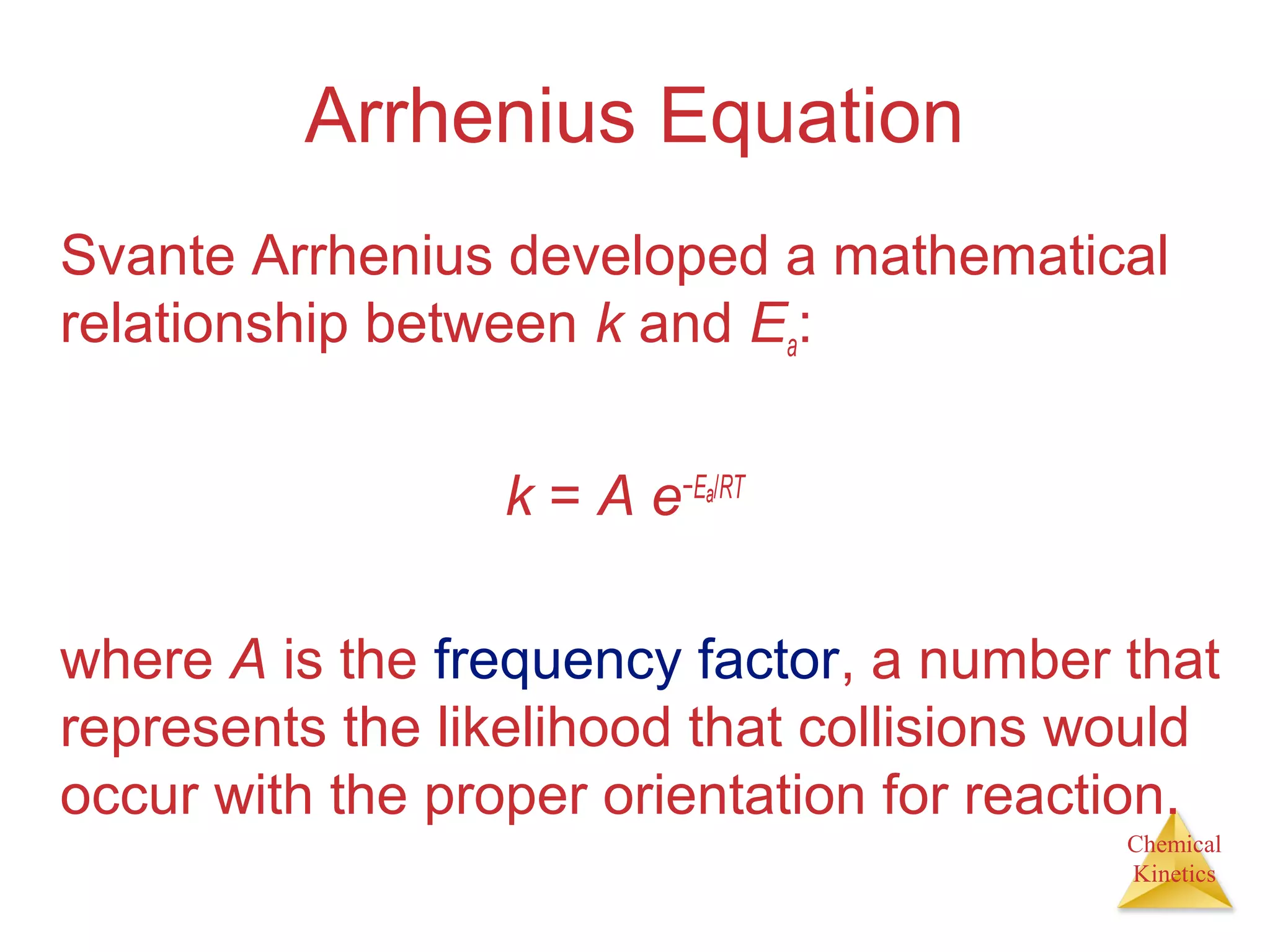
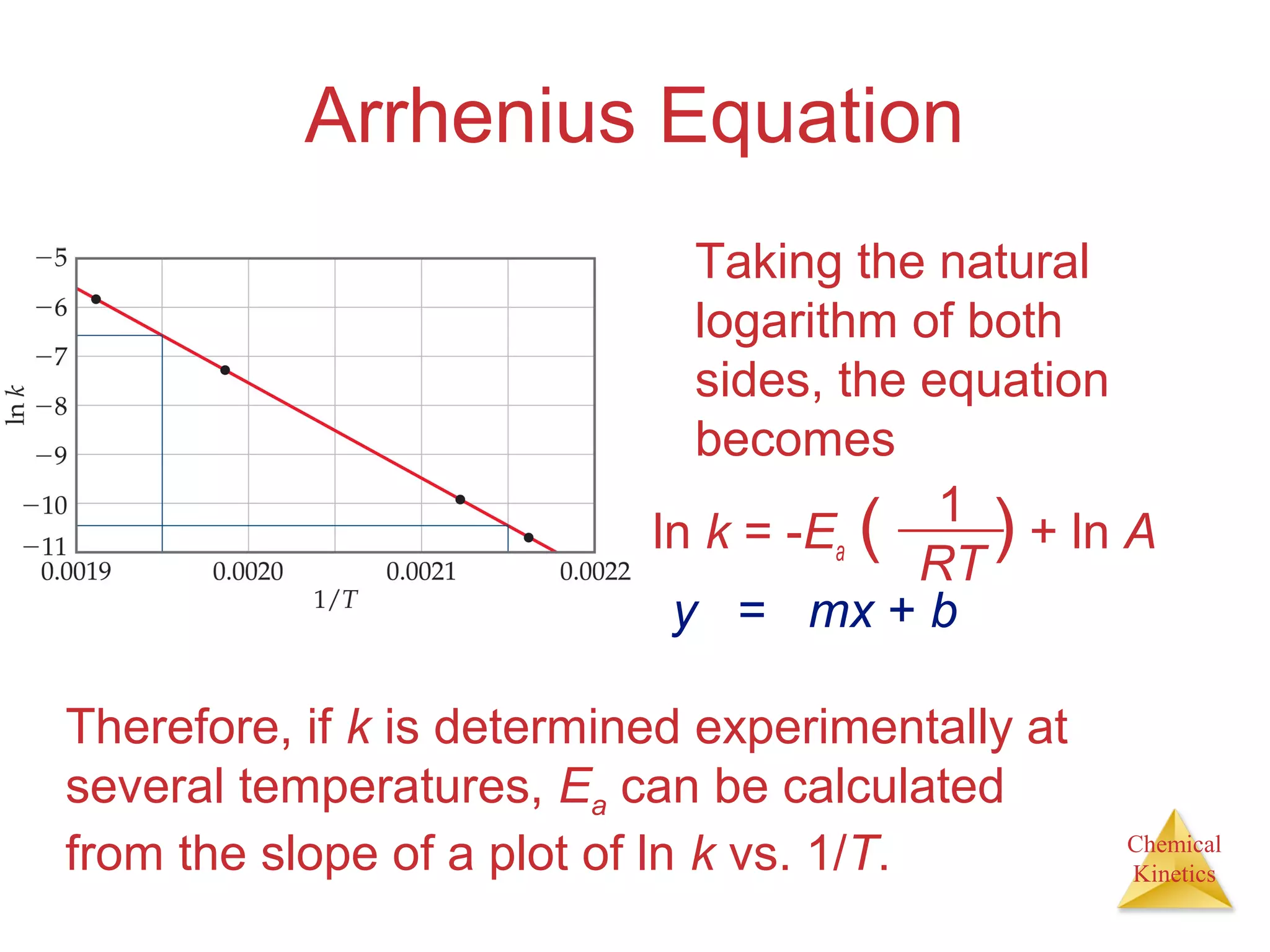

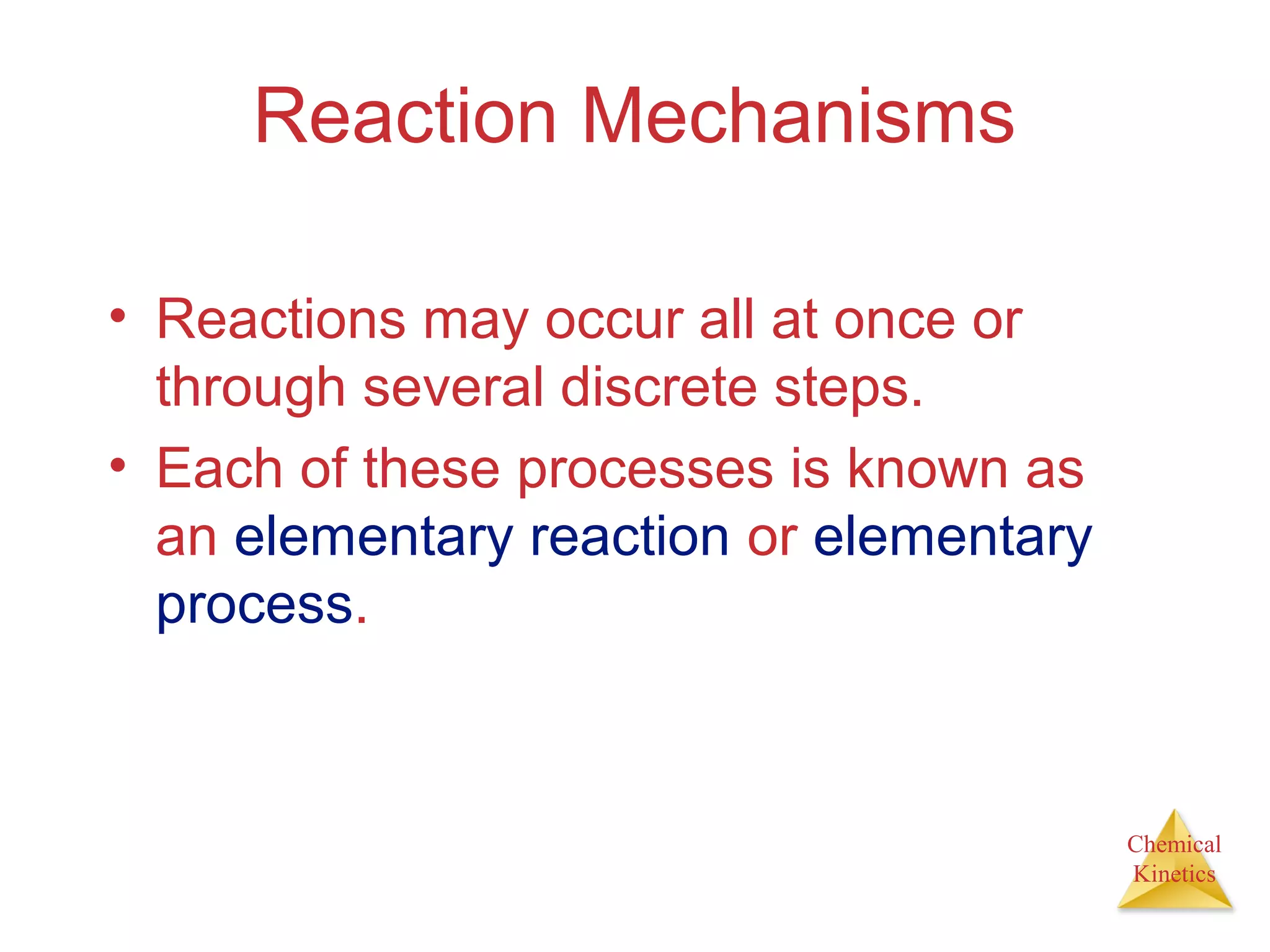
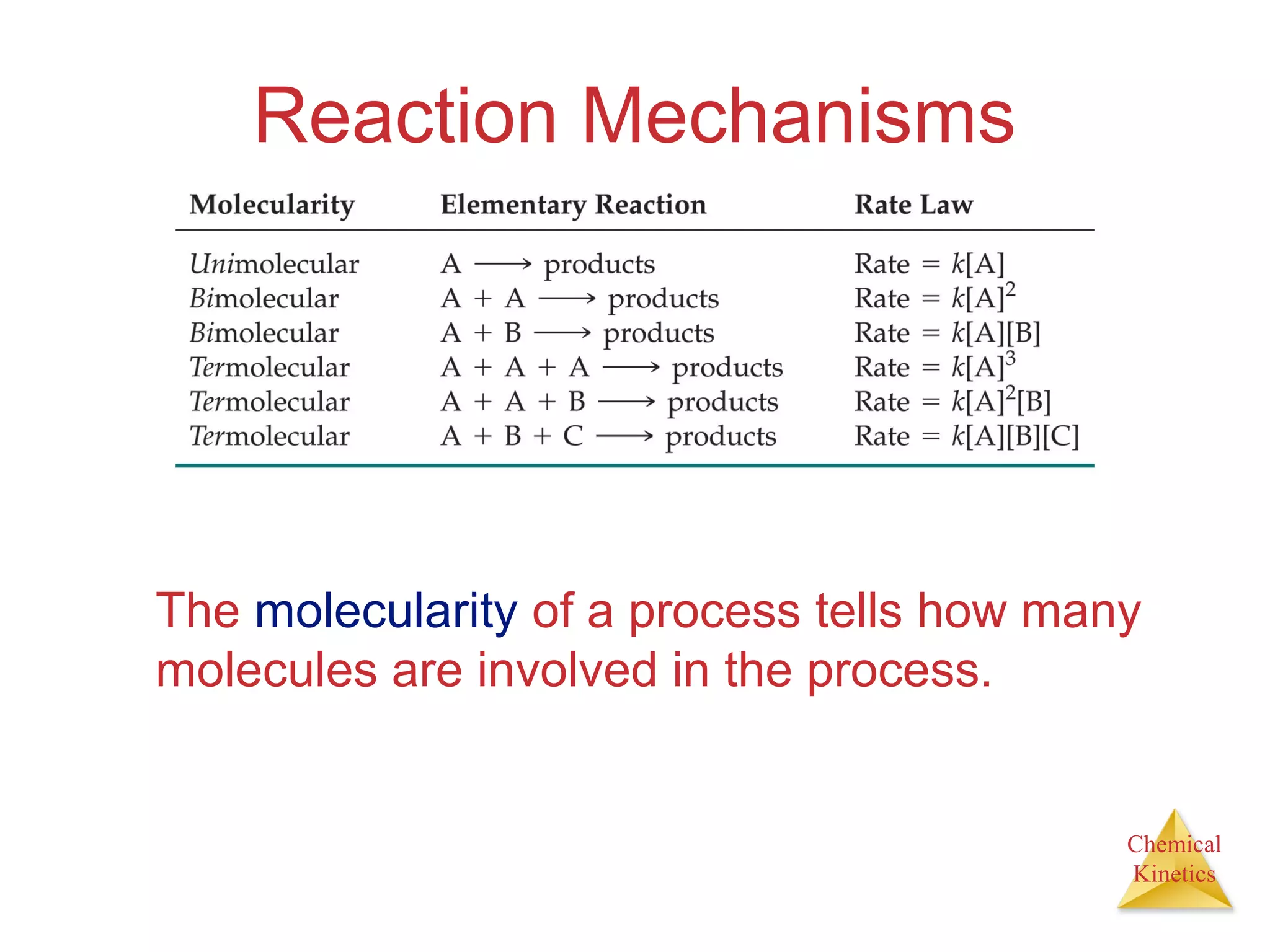
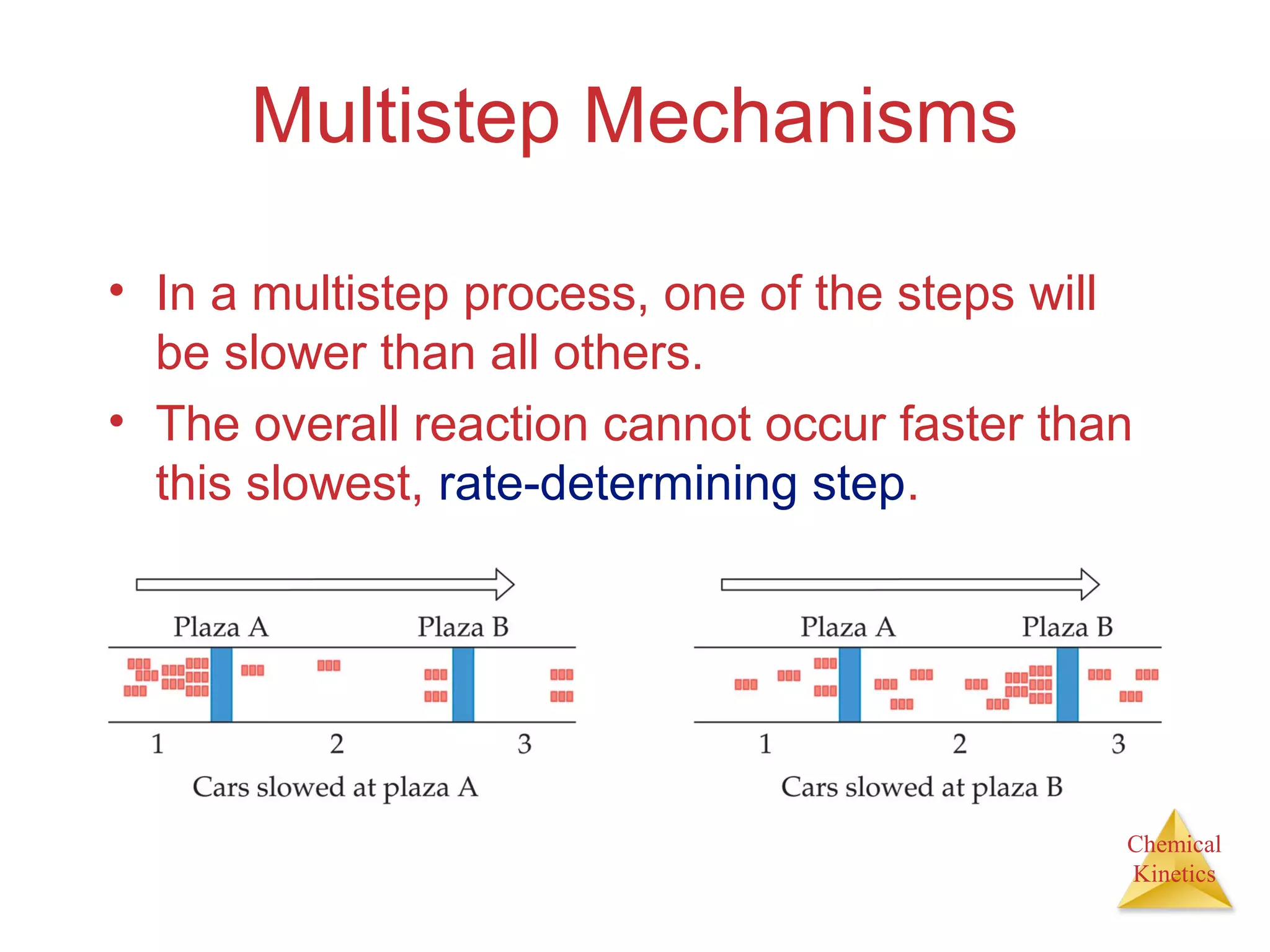
![Chemical
Kinetics
Slow Initial Step
• The rate law for this reaction is found
experimentally to be
Rate = k [NO2]2
• CO is necessary for this reaction to occur, but the
rate of the reaction does not depend on its
concentration.
• This suggests the reaction occurs in two steps.
NO2 (g) + CO (g) → NO (g) + CO2 (g)](https://image.slidesharecdn.com/chapter14au-150116143226-conversion-gate02/75/Chapter-14-52-2048.jpg)
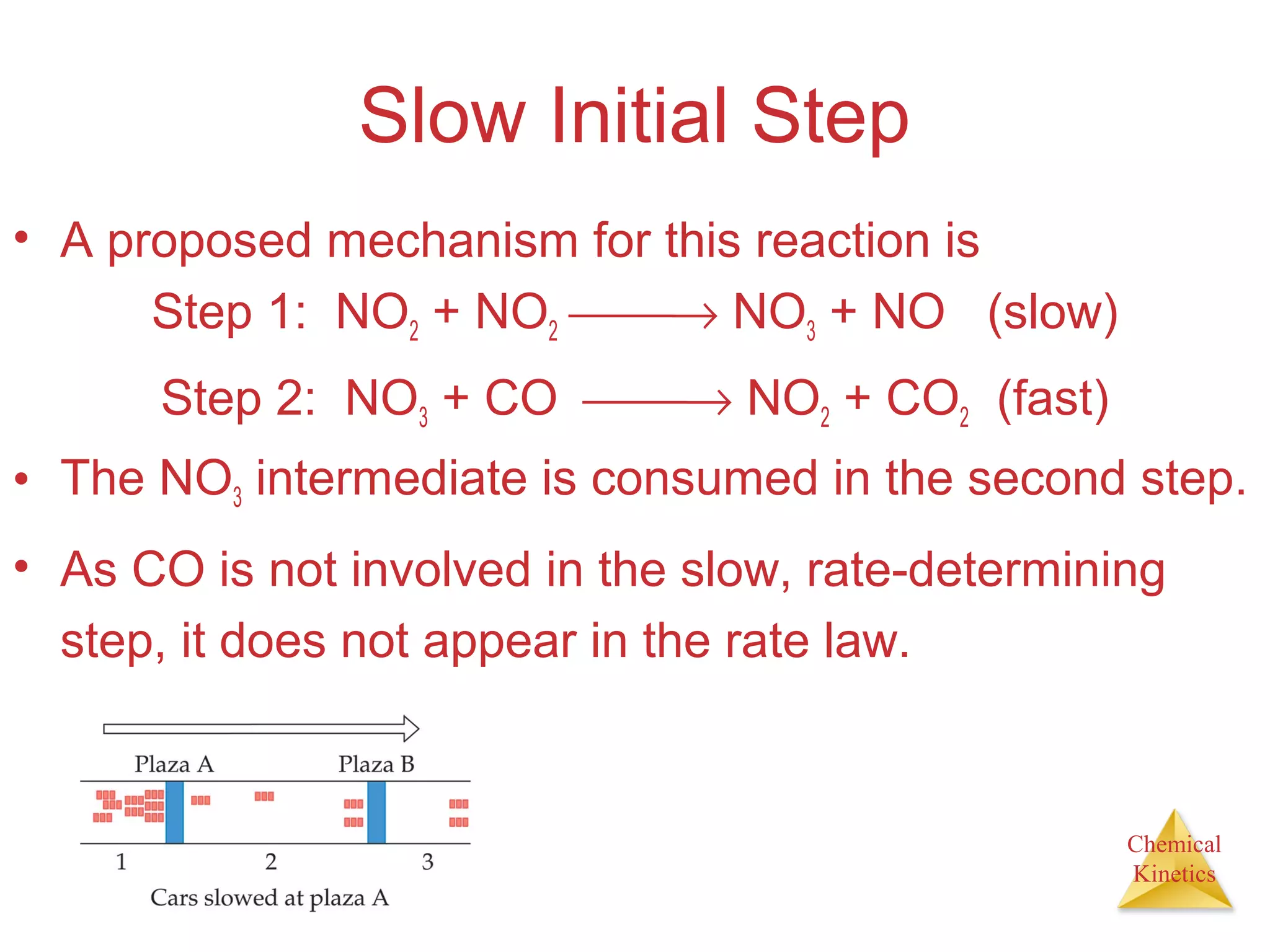
![Chemical
Kinetics
Fast Initial Step
• The rate law for this reaction is found to
be
Rate = k [NO]2
[Br2]
• Because termolecular processes are
rare, this rate law suggests a two-step
mechanism.
2 NO (g) + Br2 (g) → 2 NOBr (g)](https://image.slidesharecdn.com/chapter14au-150116143226-conversion-gate02/75/Chapter-14-54-2048.jpg)
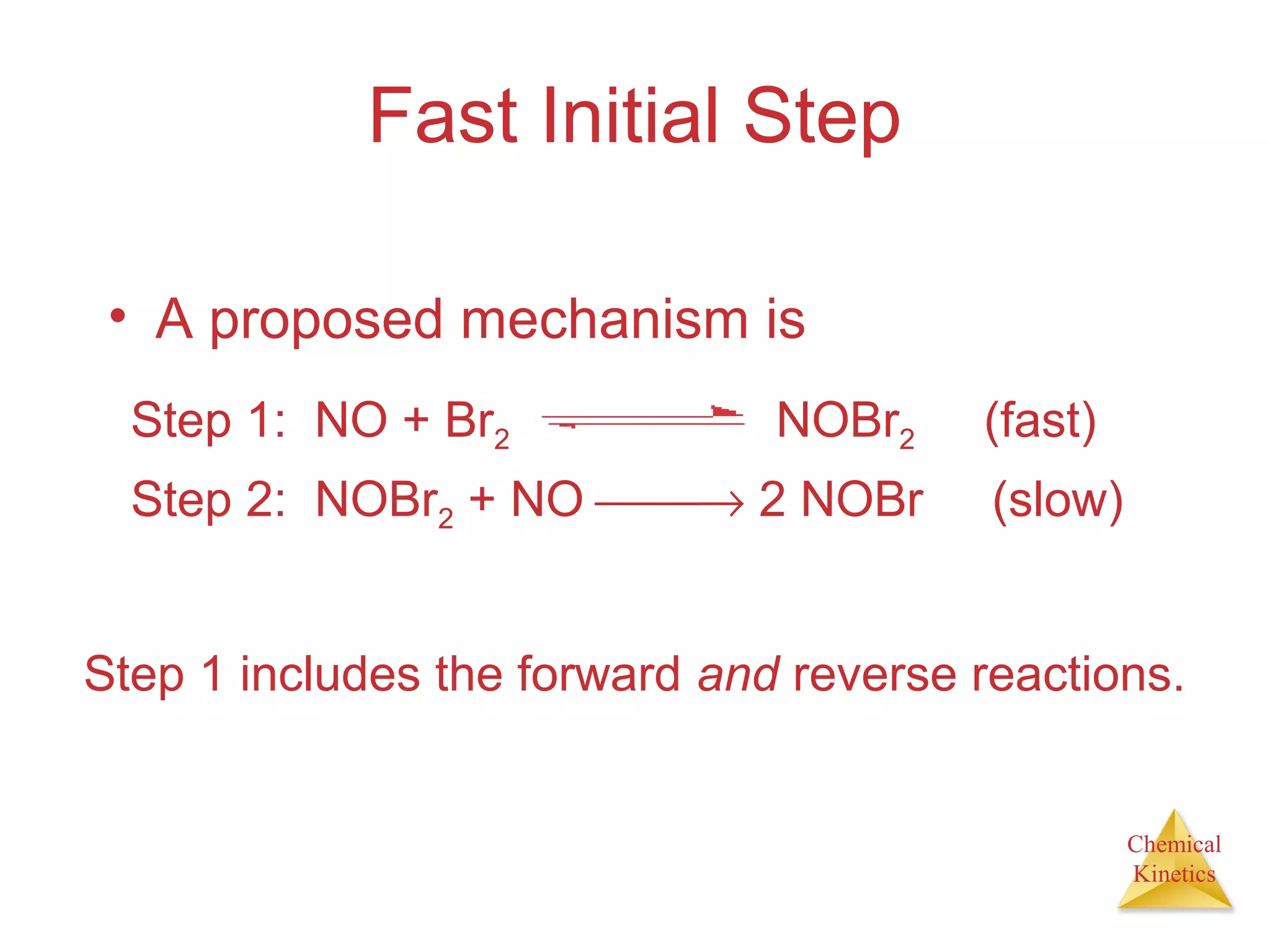
![Chemical
Kinetics
Fast Initial Step
• The rate of the overall reaction depends
upon the rate of the slow step.
• The rate law for that step would be
Rate = k2 [NOBr2] [NO]
• But how can we find [NOBr2]?](https://image.slidesharecdn.com/chapter14au-150116143226-conversion-gate02/75/Chapter-14-56-2048.jpg)
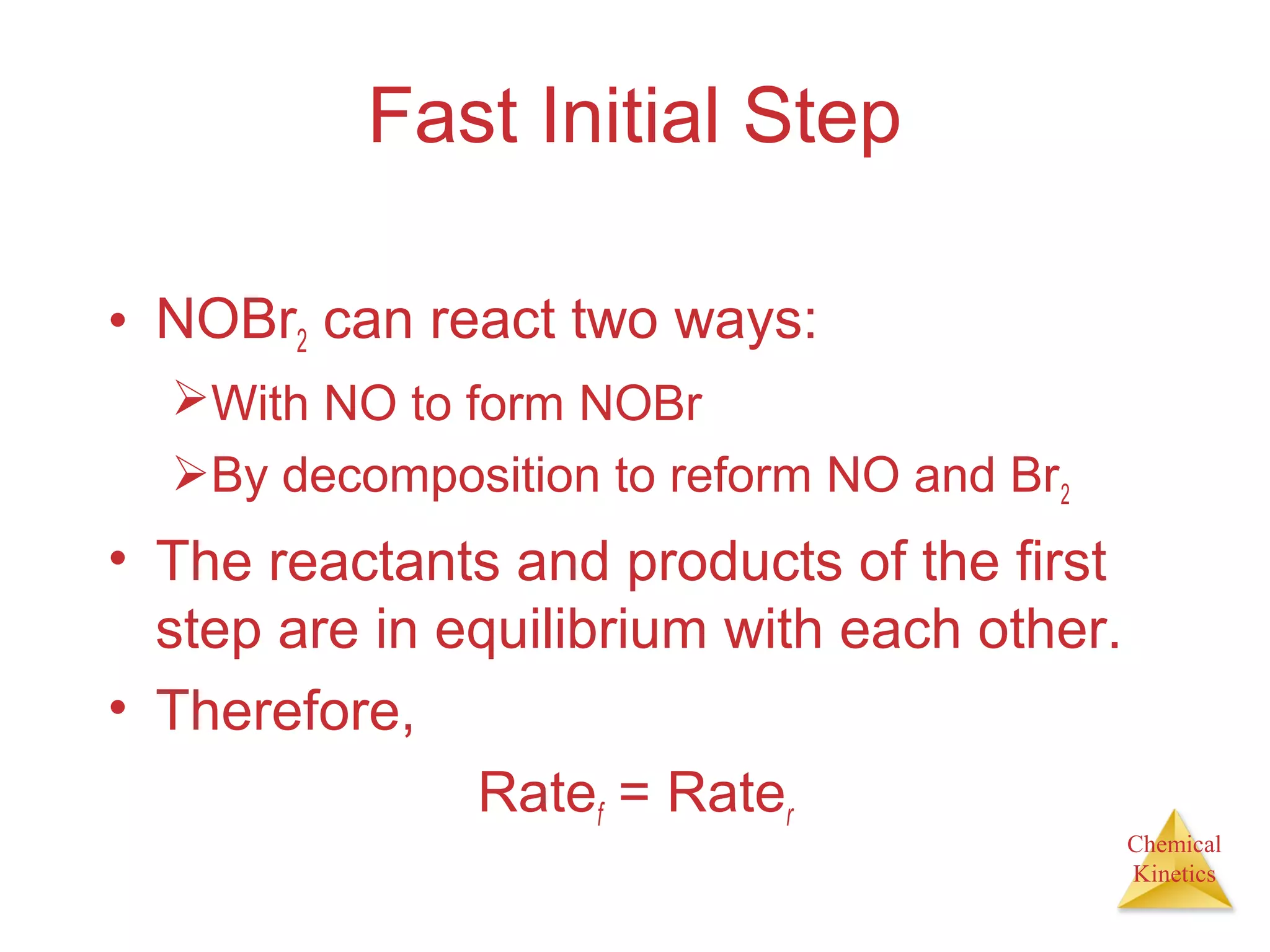
![Chemical
Kinetics
Fast Initial Step
• Because Ratef = Rater ,
k1 [NO] [Br2] = k−1 [NOBr2]
• Solving for [NOBr2] gives us
k1
k−1
[NO] [Br2] = [NOBr2]](https://image.slidesharecdn.com/chapter14au-150116143226-conversion-gate02/75/Chapter-14-58-2048.jpg)
![Chemical
Kinetics
Fast Initial Step
Substituting this expression for [NOBr2]
in the rate law for the rate-determining
step gives
k2k1
k−1
Rate = [NO] [Br2] [NO]
= k [NO]2
[Br2]](https://image.slidesharecdn.com/chapter14au-150116143226-conversion-gate02/75/Chapter-14-59-2048.jpg)
